 |
Baraka - 2017 Alaska
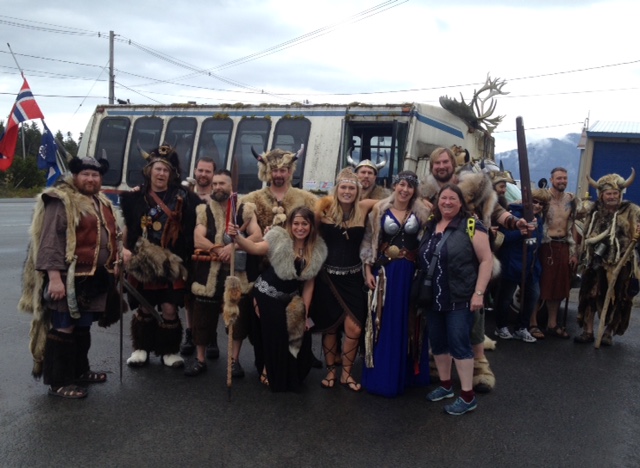
May 19 - Petersburg
Joel took us to SeaTac with too.much.luggage. All 3 checked bags got labelled Heavy. Flight 65 heads north in quick hops, Ketchikan, Wrangell, Petersburg.
Our flight was met by a rowdy horde of vikings! It is the annual viking fest here. People deck themselves in real horns, antlers and skins, probably shot in the backyard. John Margus loaned us a car, parked waiting at the airport, so we loaded our bags and headed into town.
We grabbed street food lunch, then rolled down to the Waterfront B&B to check in. We will stay in comfort while re-rigging Baraka. Then we headed to the boat to see what a Petersburg winter could do. The boat is in surprisingly good shape. A little green algae on the decks, but dry inside thanks to a dehumidifier. We got to work, Jan rerigging and stowing while Dave worked on batteries and bilges. The bimini is back up, caprail covers stowed, fenders on the rail, and some lines re-run. Tomorrow we hit the storage unit and start ferrying cushions, mattress, bedding, towels and sails back aboard.
Lots to do, but so far encouraging.
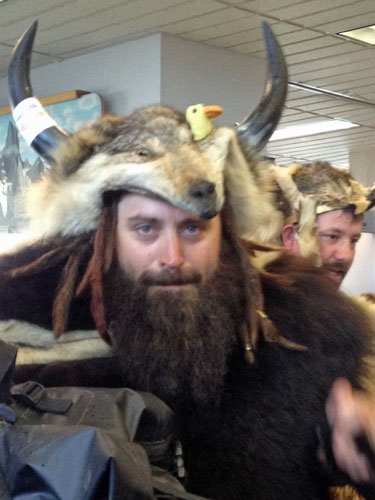
This fierce viking seems to have a stuffed duckie poking out of his wolfskin-horn hat.
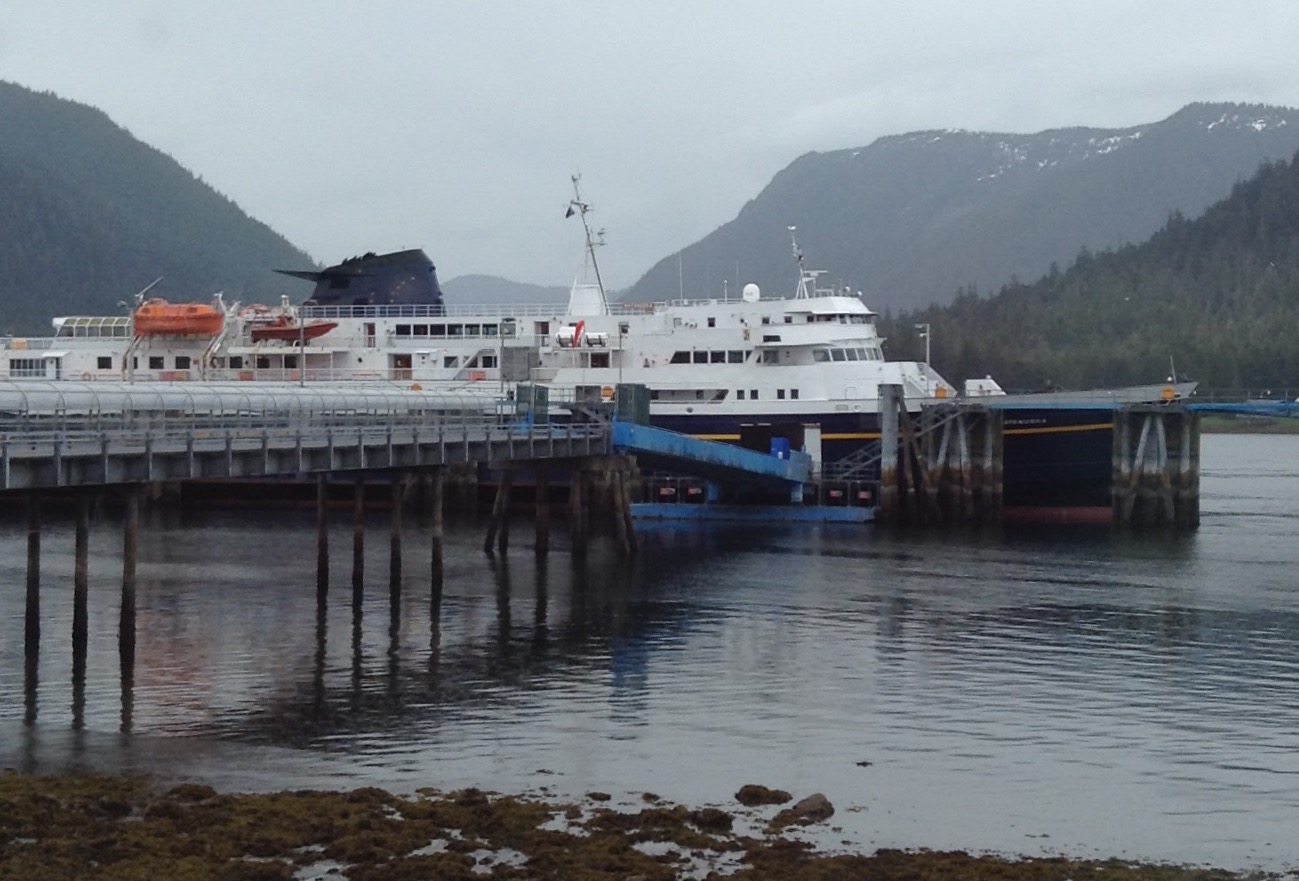
May 21 - Petersburg
View from our B&B bedroom: the Matanuska docks in front.
Delightful to work all day, then come "home" to comfort at the the Waterfront B&B. Yesterday we made multiple trips to the storage unit, located almost adjacent to the haulout yard, and loaded dozens on bags of gear back aboard. Dave is glad he's done lots of arm curls at the gym. Most could be hauled up by hand, though some, like our big mattress, trussed like a tootsie roll, had to be winched aboard. We got the last load up just as the rain began.
The storage unit is now empty, except for the heavy jib and 2 crates of canned goods. We may wait until we are floating at the docks to get those aboard. We are very glad we elected to store our gear in a heated storage unit. That, plus the dehumidifier on Baraka allowed us to return to a dry boat.
Dave is hard at work with a long checklist. Mine is shorter, a good thing because I had a computer issue that needed attention.
May 22 - Petersburg, last day on the hard
Little by little, Baraka is looking herself. We ran a hose and siphoned out the water tanks, dabbed some bottom paint at the waterline and on the nose where a few bergie bits had scraped us clean, and scraped, then sprayed barnacle buster on the prop. Inside, I rehung curtains, made up the bed, and stowed the stuff that had been in storage. We made a final run to B&G Storage to load the last items and settled up our bill. We are so glad we did this - no mildew anywhere.
The yard launched another sailboat today, rolling the trailer into the water until the boat gently floated free. Our turn tomorrow. We still have a long list of in-the-water chores, but the yard list is now complete.
Dave has a new laptop computer, so I got our hockey-puck GPS working on it. The mushroom GPS on the stern is too old - no drivers available for Windows 10. Tomorrow I'll see it if it can pick up our AIS receiver.
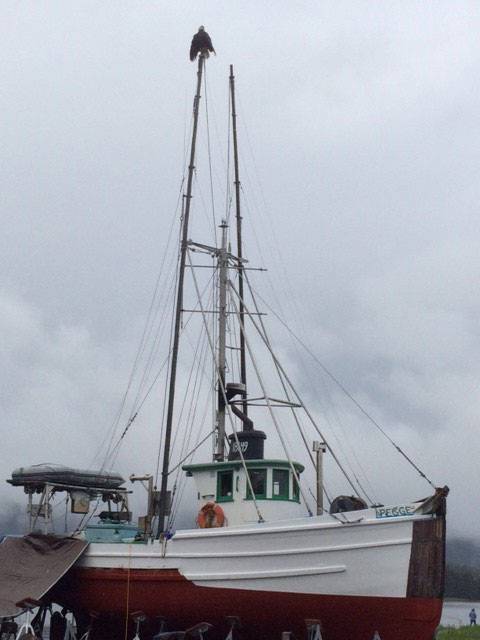
Eagle perched on Pegge
Amanda cheerfully works on her boat in the yard as we are prepping to launch Baraka. She has a visiting eagle on top of her poles, spreading its wings to dry after the non-stop rains. Amanda is a single-hander, running her trawler for salmon and halibut out of Petersburg.
May 23 - Afloat!
This morning we packed up and settled the B&B, then drove to the Petersburg Marina to arrange moorage. The harbormaster slotted us into a berth in the north harbor, our first choice. Back at the yard, we prepped for launch. John and crew eased Baraka slowly down the ramp. Once the seawater intake was submerged, we started the engine. Dave ran below to "burp" to shaft seal, to restore water needed for lubrication. Soon we drifted free, and motored north to the marina. We arrived at slack, and grabbed our berth. Dave worked on dock power, we filled a water tank, and got the head working.
This evening we ran into the first hitch - a water leak in the fresh water system. The pump is slowly emptying the small starboard tank into the bilges. Dave is thinking one of the copper pipes may have frozen and split, though he emptied the water system.
May 26 - A boat!
Dave heroically fixed one leak after another. Despite a lot of work last fall winterizing Baraka, our elderly copper pipe freshwater system failed. There is still yet one more leak somewhere, out of sight and reach. We are resigned to having only foot-pump access to our freshwater tanks. Not a showstopper - it is essentially what we do at sea, but inconvenient when we have guests.
Rolfe and Bev arrived yesterday and quickly were shanghaied into service. Bev helped me scrub the topsides and mark the anchor chain. Rolfe helped raise the jib, replaced the autopilot head, lowered the outboard, and spent a few futile hours attempting to rescue Dave's iPhone that dove into the bilges when Dave was trying to take photos of the leaks under the flooring. Very sad event, losing Dave's phone. It was a hand-me-down gift from Joel. So now we await Joel's next upgrade!
One by one the boat systems woke up: diesel heater, generator, outboard engine. Except for the water leaks problem the boat seems to have survived the winter well.
Bev and I made a provisioning run. I did a load of laundry and Dave bought a fishing license.
Weather looks benign! After some weeks of working, getting Dave's sister moved to a new home, getting our own house ready to rent, packing for the summer, prepping the boat in the yard and at the docks, we are finally ready to reap some of the rewards, cut loose from the docks and head to quiet anchorages.
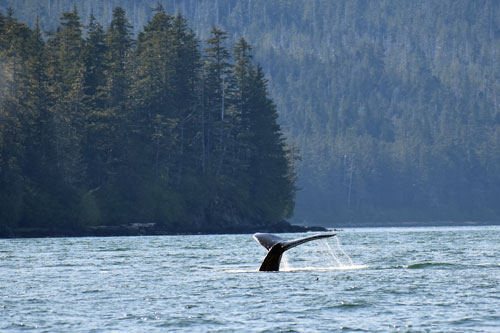
Frederick Sound Humpbacks
May 28 - Warm Springs Cove, Baranof
Yesterday we awaited the afternoon slack to get away from Petersburg Marina. The currents can rip through at 4-5 knots, swirling whirlpools around the boat. We cast off and got away with no problem, motoring out of Wrangell Narrorws into Frederick Sound. We spotted our first humpbacks as we worked north in flat water to Read Island, where we anchored in a pretty cove for a good night's sleep.
Today we woke to another sunny day, no wind, so we took advantage of the benign conditions to go 59 miles to Warm Springs (aka Baranof Hot Springs) on Baranof Island, tucking into tiny, sheltered Schooner Cove. A huge eagle perched on the nearby net shack, swooping down to catch fish. Dave and Rolfe tossed the crab trap in. Tomorrow we will explore and maybe take a dip in the hot springs.
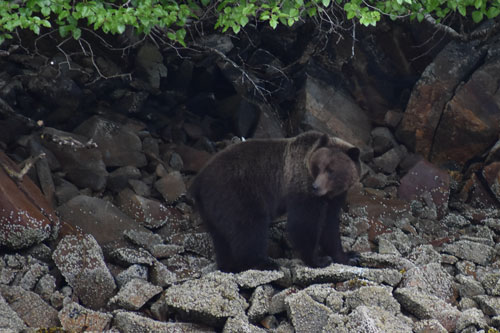
A brown bear (aka grizzly) stolls along the beach at Schooner Cove anchorage.
Jan poked her head out in the morning and noticed a bear slowly scanning the beach, ignoring us. Rolfe and Bev both got some terrific pictures as it ambled along.
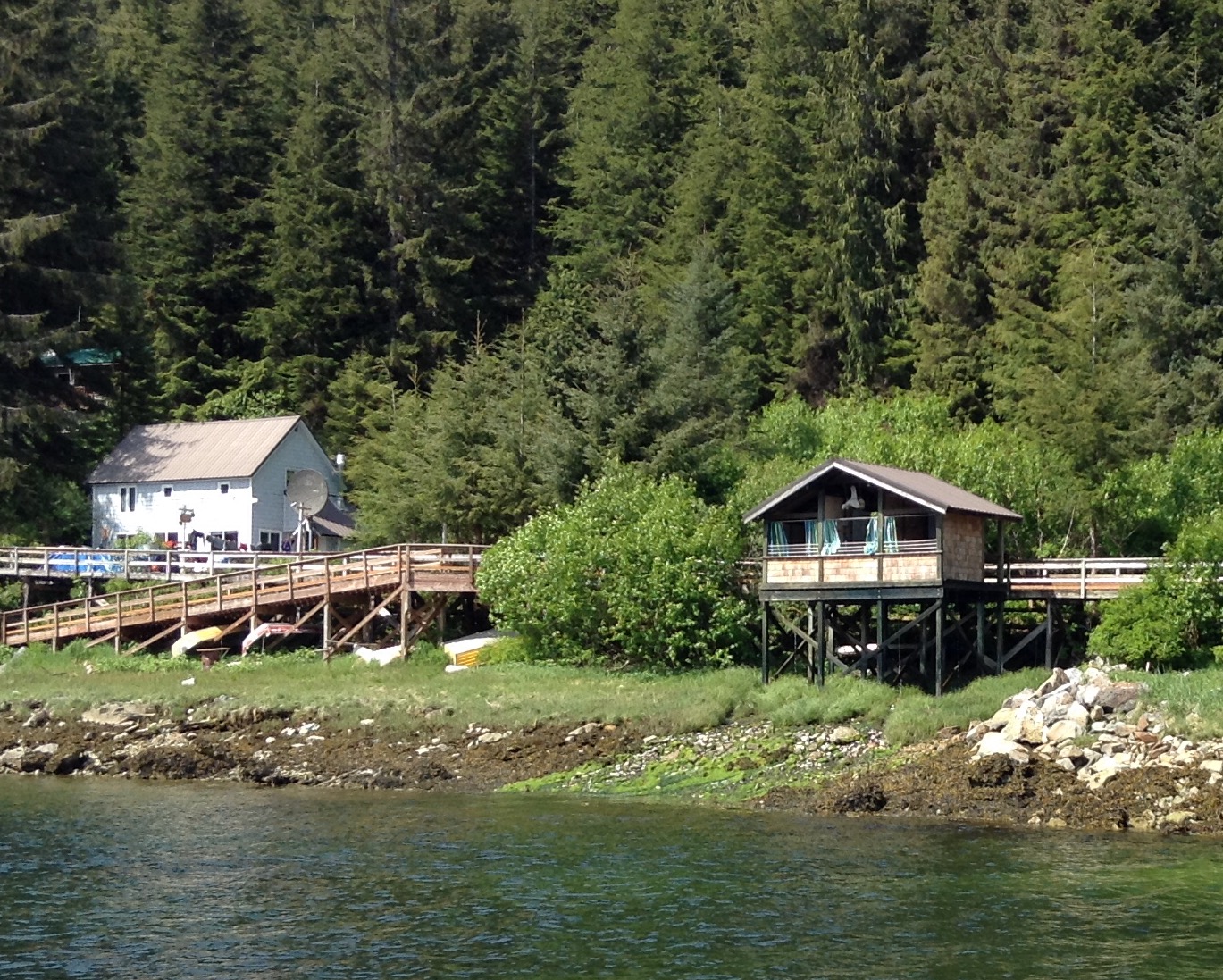
May 30 - Baranof Hot Springs
Dave dinghied Rolfe and Bev to the docks, to hike to the hot springs near the waterfall, while we did a small repair to the head. We grabbed our towels and headed into the bath house. At Baranof you have choice: natural basins (hot and hotter) or private bath house rooms with huge tubs. The tubs have 2 inlets, hot and cold. You open and close the valves to set the temperature as hot as you can stand. Dave and I luxuriated in the tub, with the curtain open to view snow-capped mountains. Bliss...
The docks were empty enough to bring Baraka over. On the way to fetch her we thought an eagle was in distress, seemingly caught. It was surrounded by other eagles, who we assumed were protecting him. But more likely he just had a load of dead fish, too heavy to lift, and the companion eagles were hanging close hoping he'd forfeit his prize. A local man went to assist the eagle, after Rolfe alerted him, but by then the eagle could fly away.
We motored to the dock in time for Rolfe and Dave to catch the high tide into the nearby salt lagoon, a rowdy ride in currents through a narrow channel. At low water the entrance is a waterfall!
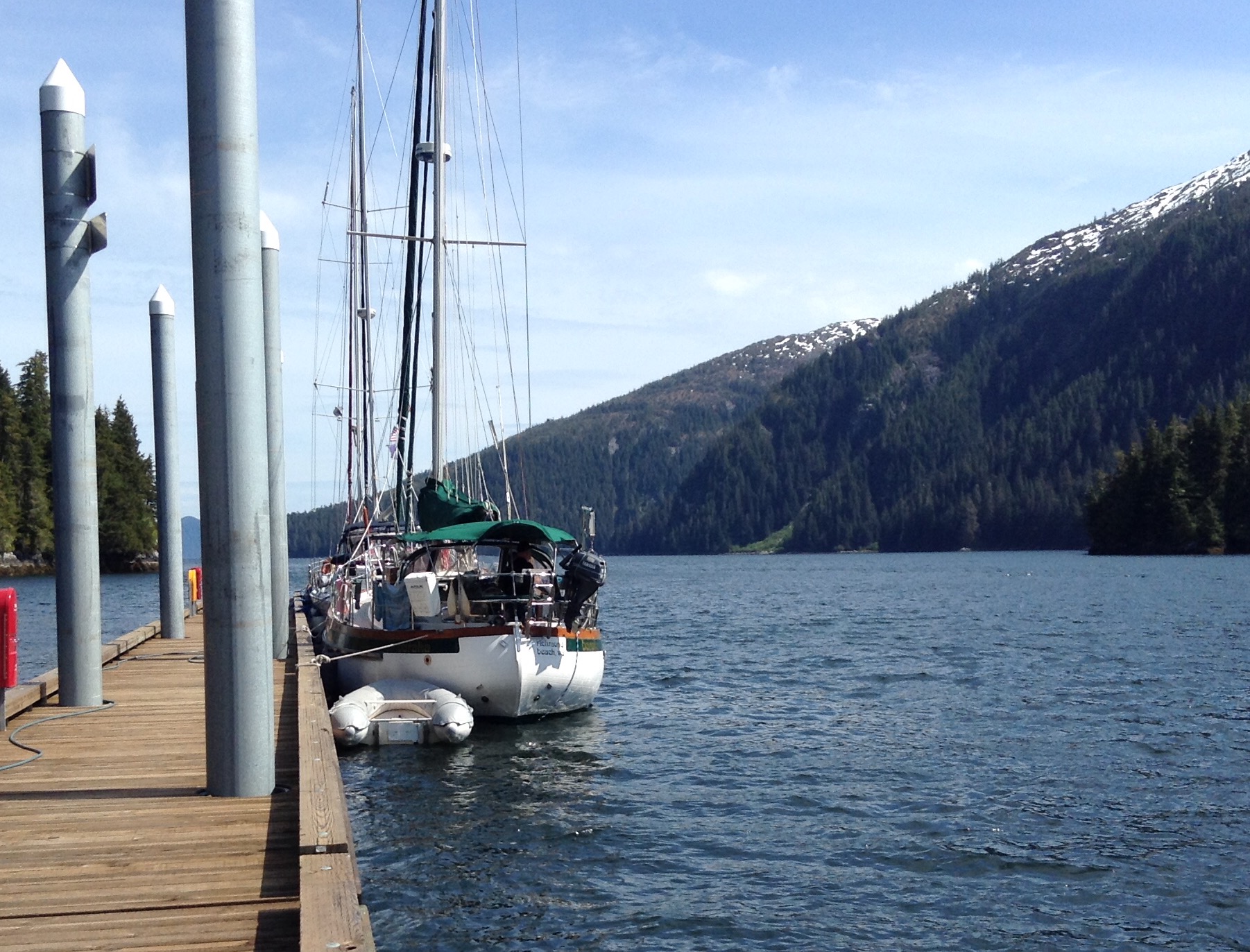

May 31 - Angoon
We zigged across Chatham Strait to Angoon, a native Tlingit village, arriving 2 hours too early to enter the cut, so we anchored outside to await slack. In early evening we motored inside for a quiet night just off of the town marina. The head packed up, so we were interested in shore facilities. Small skiffs trolling for Kings glided past in a loop around our anchorage.
Early the next morning we dinghied to the dock. Eureka! A "full service" marina, with an outhouse on the end of the dock, clean drop to the water. Bev could not grant it 5 stars as the door would not stay shut.
We walked into town to find a somehwat run-down community, broken windows, a russian orthodox church, graveyard, some native painting and carving. An Alaskan subsistance economy, worn by harsh weather and limited resources. We have to admire the people who make it through the winter in these lands.







June 1 - Tenakee Springs
We zagged back across Chatham once more to Tenakee Springs, a charming town built on pilings, populated by a handful of hearty year-round residents plus a vacation/fishing getaway for Juneau residents, who can arrive by ferry or float-plane. Several log cabins were well over 100 years old.
Tenakee also has a hot springs bath, most welcome for our crew since Baraka's pressure water/hot water system has a leak.
By now our the head was seriously misbehaving. Rolfe and Dave ran 500' of hose to blast out an obstruction while Jan took the carcass ashore to dismantle and rebuild it with new parts, a task we must do roughly every other year. Success! The head is once again doing its job.
We walked the length of Tenakee, meeting the residents and learning about their life here, and how the community is managed. Bits of quirky art and pretty gardens make the scenic walk a delight.

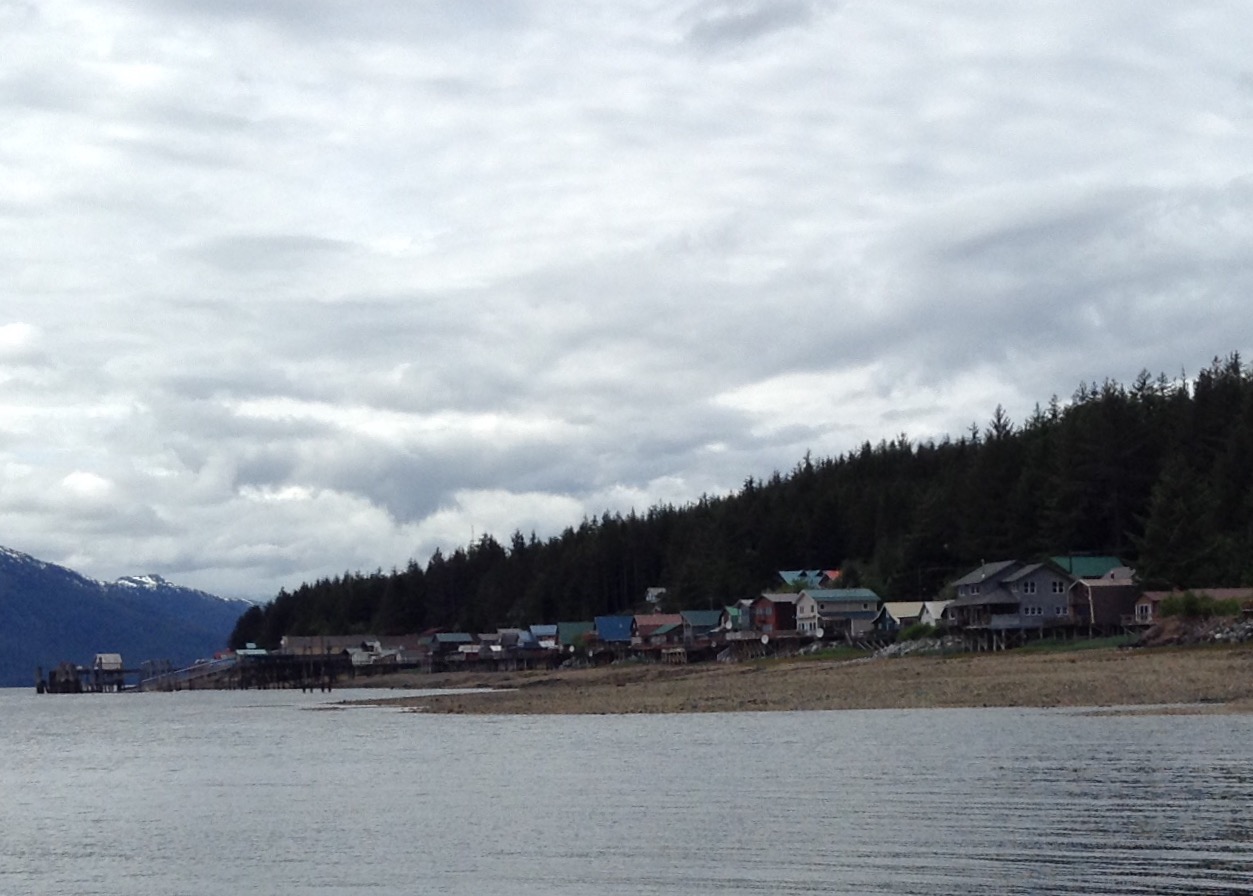

June 2 - Hoonah
On the way to Hoonah, Rolfe spots a pod of humpbacks blowing alongside. We think we spotted 7 distinct spouts, and 7 tails as they slowly dove, one by one.
Baraka had an easy run up Chatham, and turned the corner into Icy Strait - with a little drizzle and light winds. We made Hoonah late afternoon and scored a spot at the dock in time for a delish salmon bites dinner at the Fisherman's Daughter.





We walk out to the cannery museum, closed today because no cruise ships are in port. The Icy Point beach is packed with families. It's the annual kids fishing contest with lots of prizes.
Hoonah offers a sharp contrast to Angoon, benefitting from proximity to the cruise-ship destination of Glacier Bay, plus apparently a proud tradition of treasuring and preserving the Huna Tlingit culture. The city funded the restoration of the cannery to draw cruise ships, then added a cruise-ship dock, ziplines, restaurants. There is a substantial marina and haulout yard, excellent hardware store, lodging, wildlife tours, and a carving shed. Houses are modest but well kept. Folks are welcoming.
This is our third visit here, and one of our favorite stops.


Bev makes the acquaintance of White Raven.
June 6 - Hoonah
Rolfe and Bev caught the ferry to Juneau. The following day, in light drizzle, we got laundry and other boat chores done, then Joel arrived by plane. Today we walked into town to the carving shed where we met 2 of the 3 master carvers who had created Xunaa Shika Hitt, the new longhouse at Bartlett Cove. They described aspects of the front panels, the story box, the copper (representing culture and wealth) held by the eagle, with small red hands trying to take it away, and the carving that resembles a woven robe, worn by the greeter figure. They showed us a book of photos of the 2016 opening day celebrations taken by another boater. The Huna Tlingit are keeping their traditions alive.
June 8 - Bartlett Cove, Glacier Bay
We had planned to head from Hoonah directly to Elfin Cove, but a front rolled through, so instead we called Glacier Bay and got a permit to come in to Bartlett Cove for a single night. Easy trip up in flat water until we turned into the bay and current chop bounced us around a bit. We tied to the dock to check in, and found a Tlingit presentation was set to start at the long house. The park rangers gave us an abbreviated orientation so we could head to the long house to meet Owen, one of the 3 house carvers.
Owen showed us his traditonal cedar-strip hat, painted with his name sign, little frog, with an white ermine pelt attached. He told us about trapping, getting spring bear for eating, and fall bear, fattened on spawning salmon, for grease. Owen showed us his finely made spruce paddles, and said he once made 8 paddles in a single day to win a bet.
He answered questions about the long house carving, including the story of the bored girl who called down the glaciers that drove the Huna from glacier bay. She is featured in the main panel, with abalone eyes reflecting the advancing glacier. Her grandmother gave up her place in the fleeing canoes to save the granddaughter. Owen said her descendents live in Hoonah today. Her image is below the advancing glacier face, which is surrounded by 9 icebergs.
The front door of the house has a welcoming figure wearing a Chilkat robe, carved rather than woven. The house has 2 new totem poles this year. Great to see the house in use.
Yesterday we went ashore to request a second night after hearing the weather report - small craft warnings in the direction we are headed. No problem, they extended our permit.
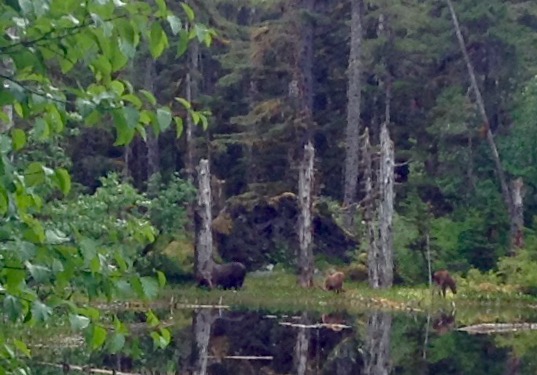
Joel went for a hike with bear spray and airhorn but met no critters. Later Dave and I did part of that loop, coming across a mother moose with 2 calves at Blackwater Pond, plus a lot of fresh bear scat on the trail, including a steaming pile in the campground.
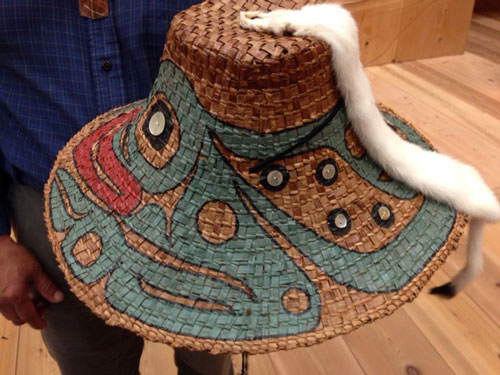
Owen James' traditional spruce root woven hat is painted with his namesake little frog. The white fur is an ermine.
Now we will try again to head west, via the north passage to Elfin Cove. We expect some bumpy seas, but the weather should now begin laying down.
June 9 - Elfin Cove
Easy trip to Elfin Cove from Bartlett Cove. We started with an adverse current that slowed us to less than 2 knots until the tide changed, then scooted through North Inian Pass at 9.4 knots, whoo hoo! We had winds on the nose to 25 knots but oddly flat seas until we got into the rollicking tidal boil just outside Inian. Turned south and threaded our way into Elfin, scoring a spot at the new (free) transient dock.
Just before entering we were met by the welcoming committee - a solo humpback that sounded left, then front, then right of us repeatedly. Dave drifted out of gear.
Elfin Cove is a cute seasonal boardwalk town, hopping now during sport fishing season. Seaplanes steadily come and go, loading fishing tourists and boxes of fish. Small boats came in to unload, weigh and clean mostly halibut, including a 131 lb whopper. We walked the length of the boardwalk, past quirkily decorated cabins sporting carvings and antlers, and tiny garden patches. Elfin seems to have cornered the garden gnome market for SE Alaska.
The local postmaster described life in Elfin Cove in the winter, when the population dives to 6. He also said a rockfall awhile back partially filled the channel to the inner harbor. Our chart says min 8 feet, but he says you can now walk across on a minus tide.
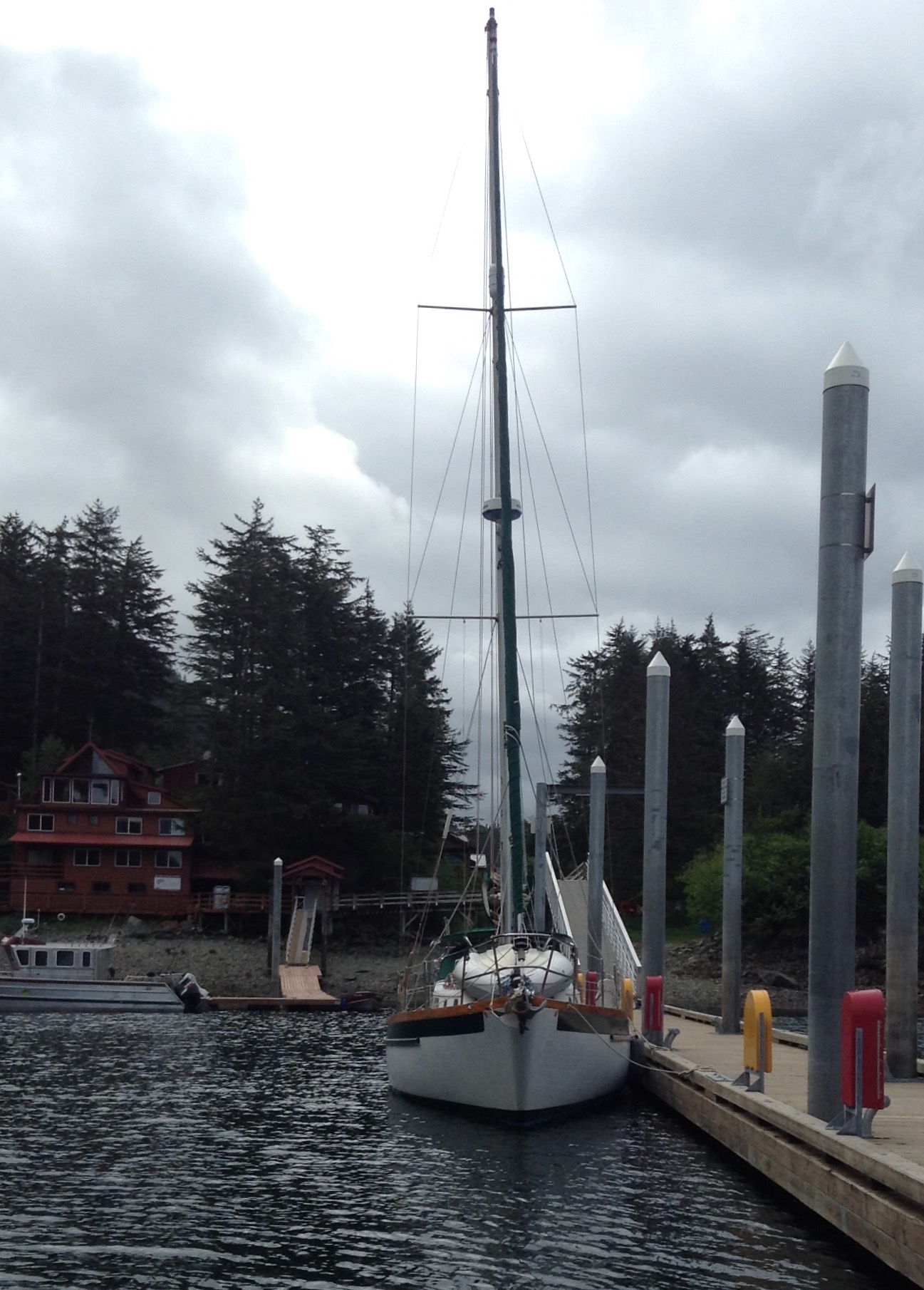
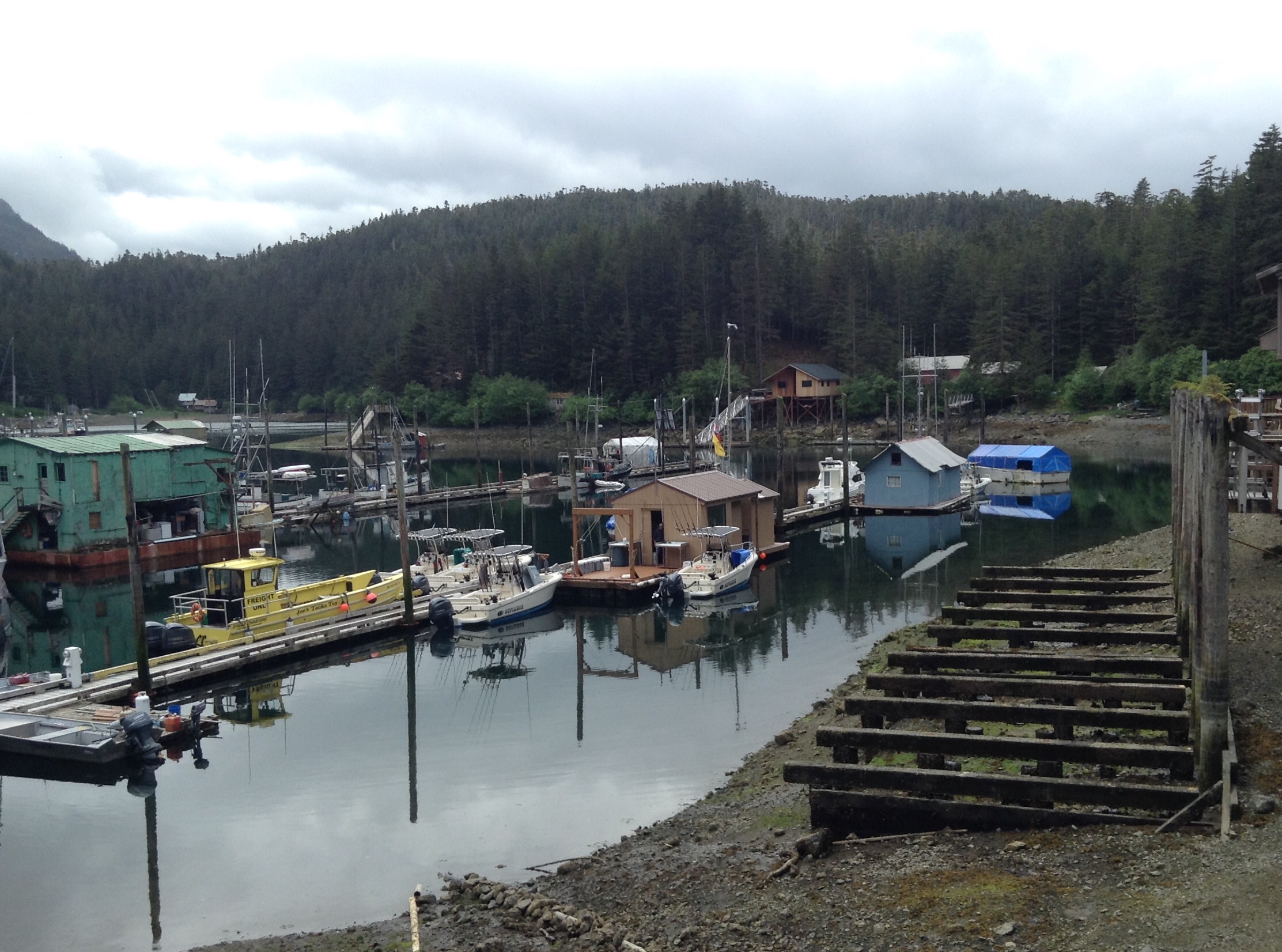
June 10 - Pelican
This morning I took a 25 cent shower, worth about that as water pressure was limited to a slow drool from the showerhead. We carried on to Pelican, another boardwalk town, on the Lisianski Channel, motoring in chilly fog. Dave remarks that we should come back here sometime in summer! We are in 4-5 layers and still chilled.
We grabbed a berth along the near-empty transient dock for $22. Pelican is pretty somnolent, though situated spectacularly below snowy mountains. Less seems to be going on here, a bit of a ghost town even though this is apparently their salmon derby. We will stay just the one night, then work our way outside, down the west side of Chichagof Island, a toothy coast with lots of remote anchorages.
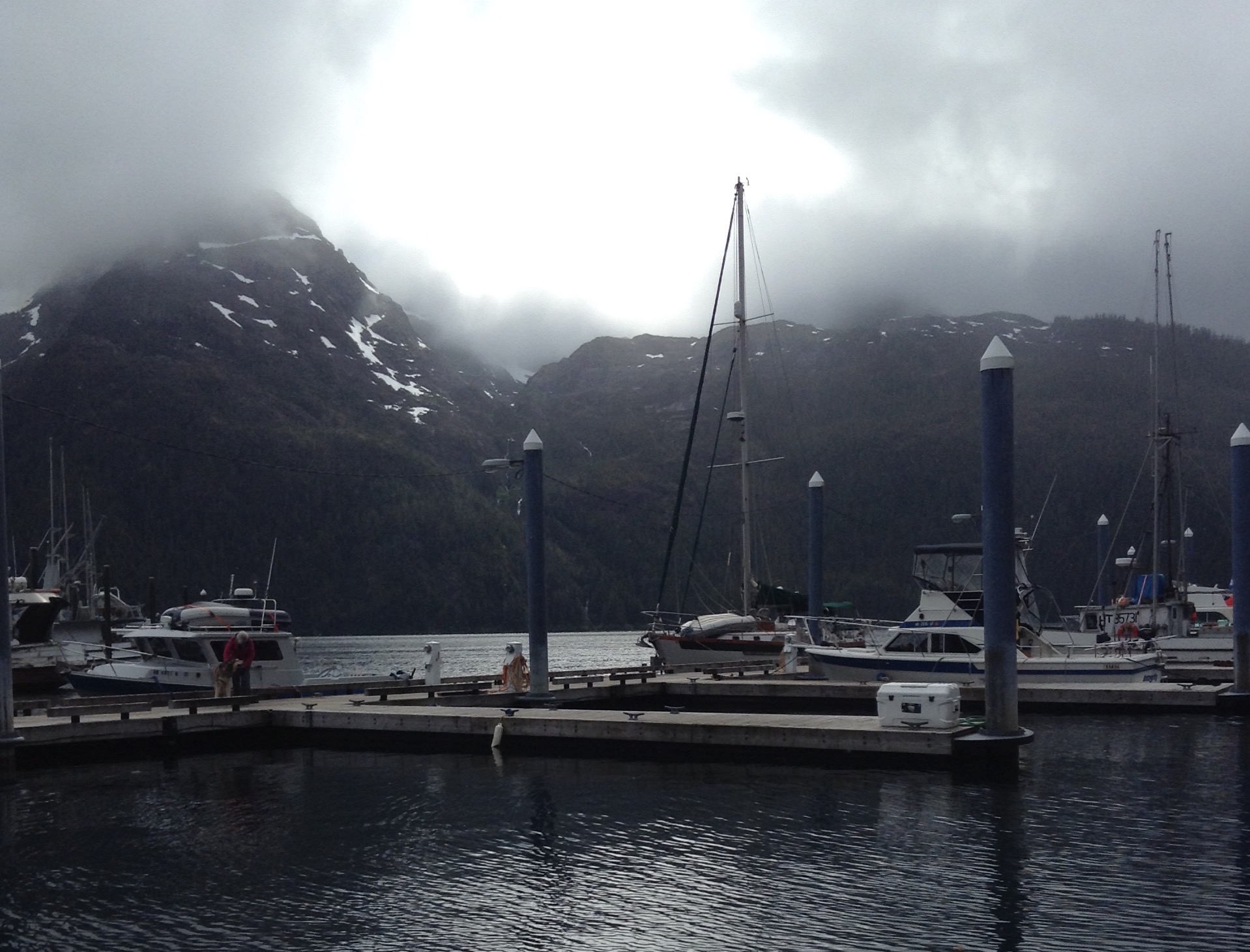
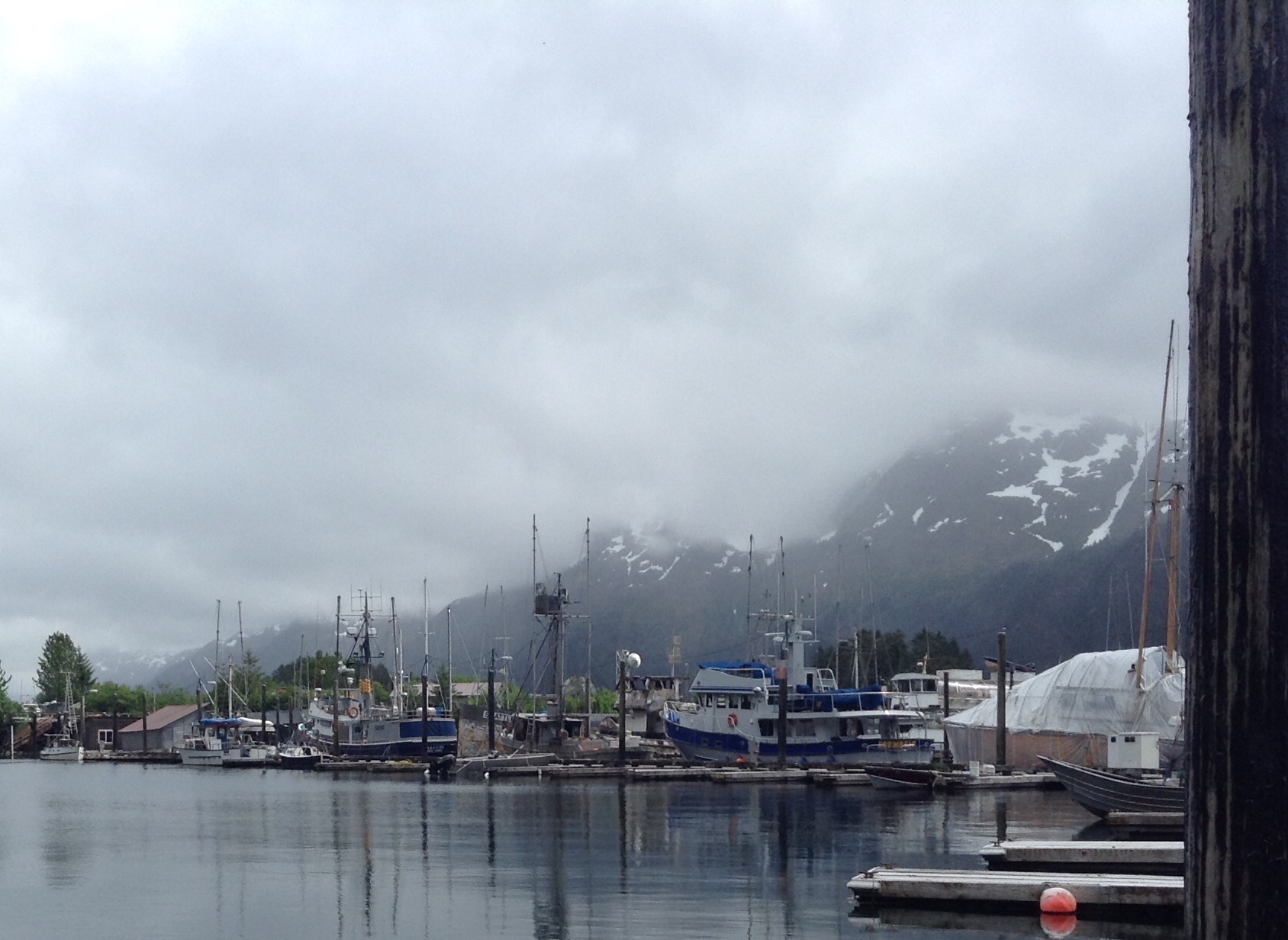
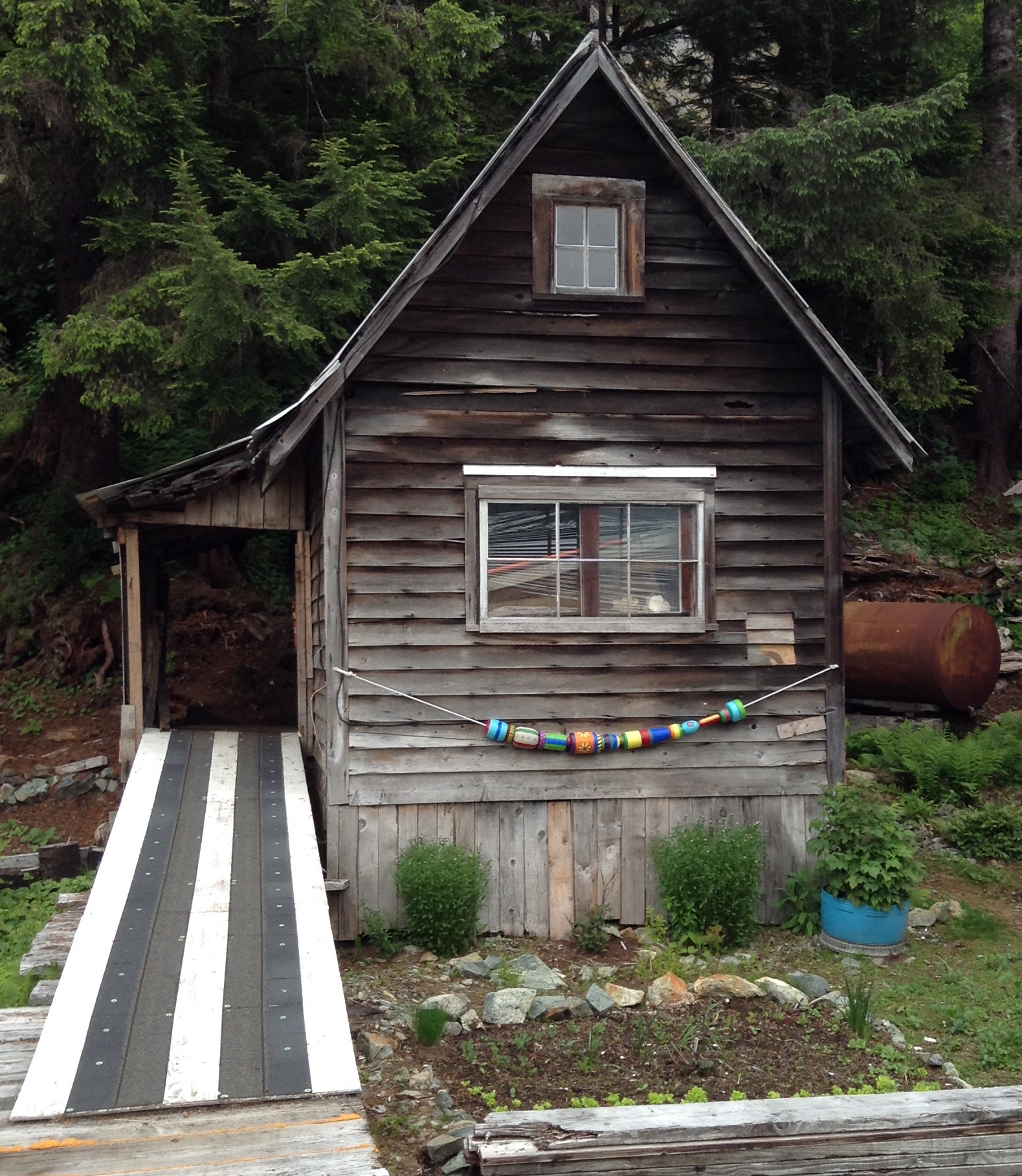
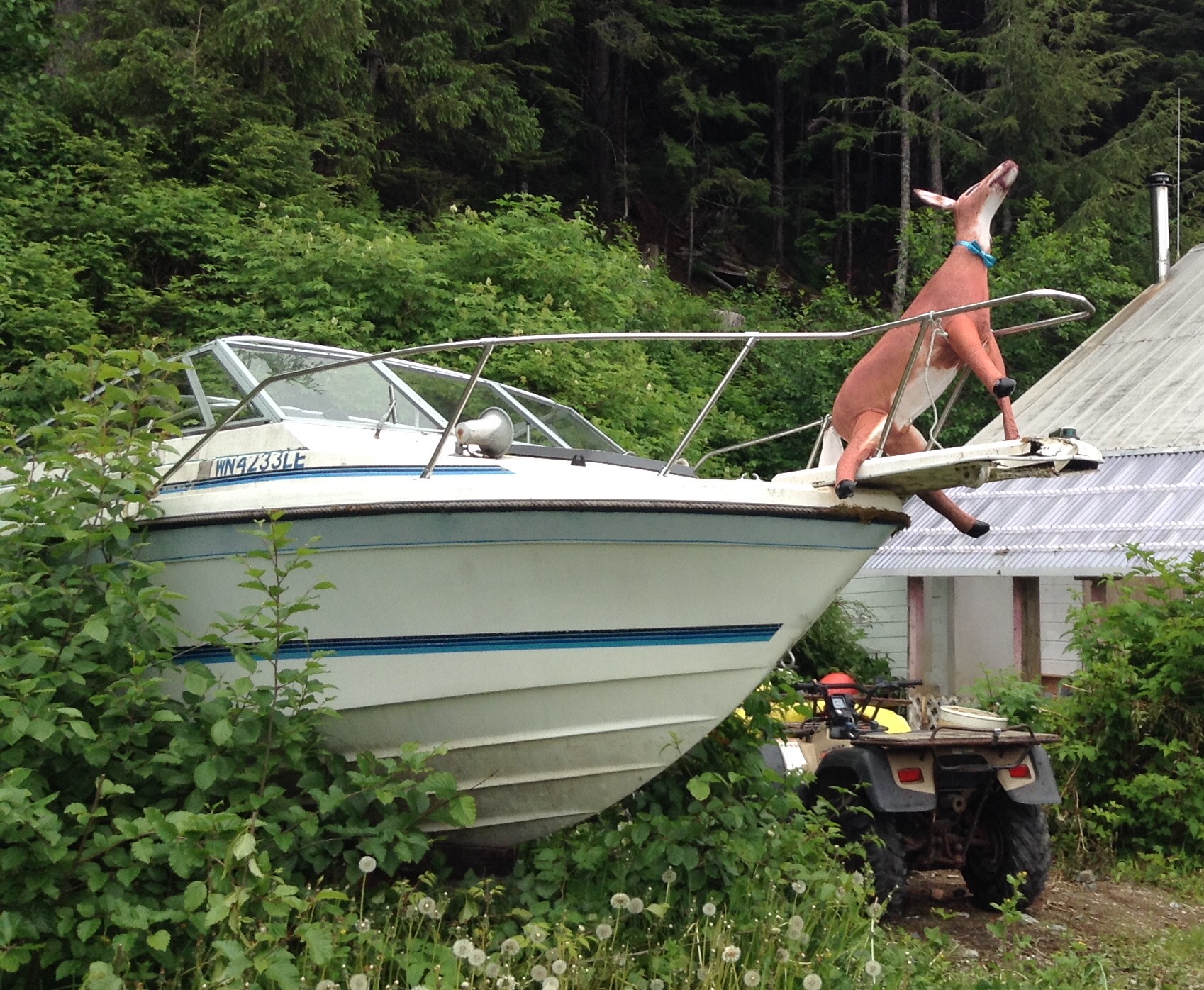

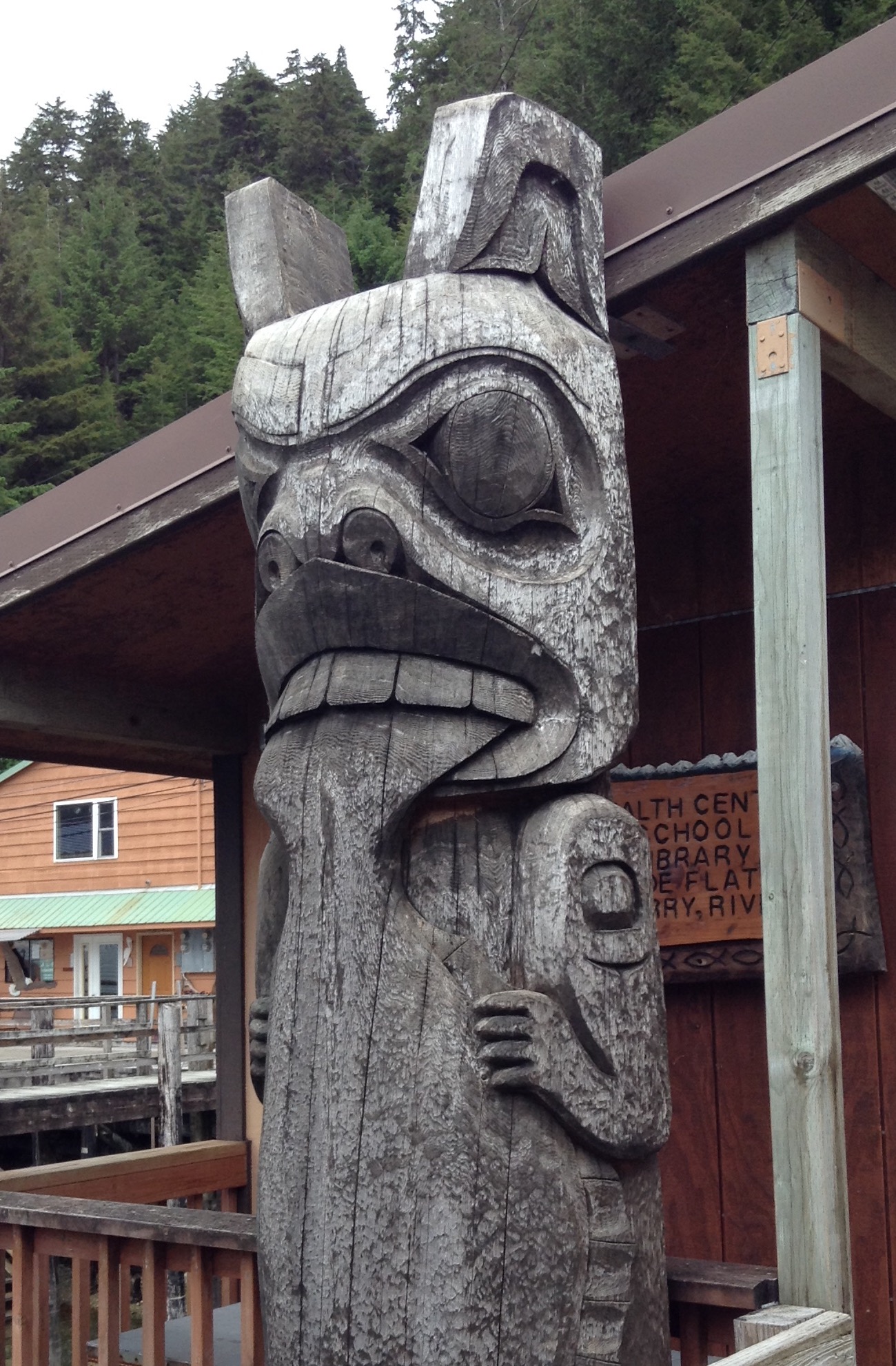
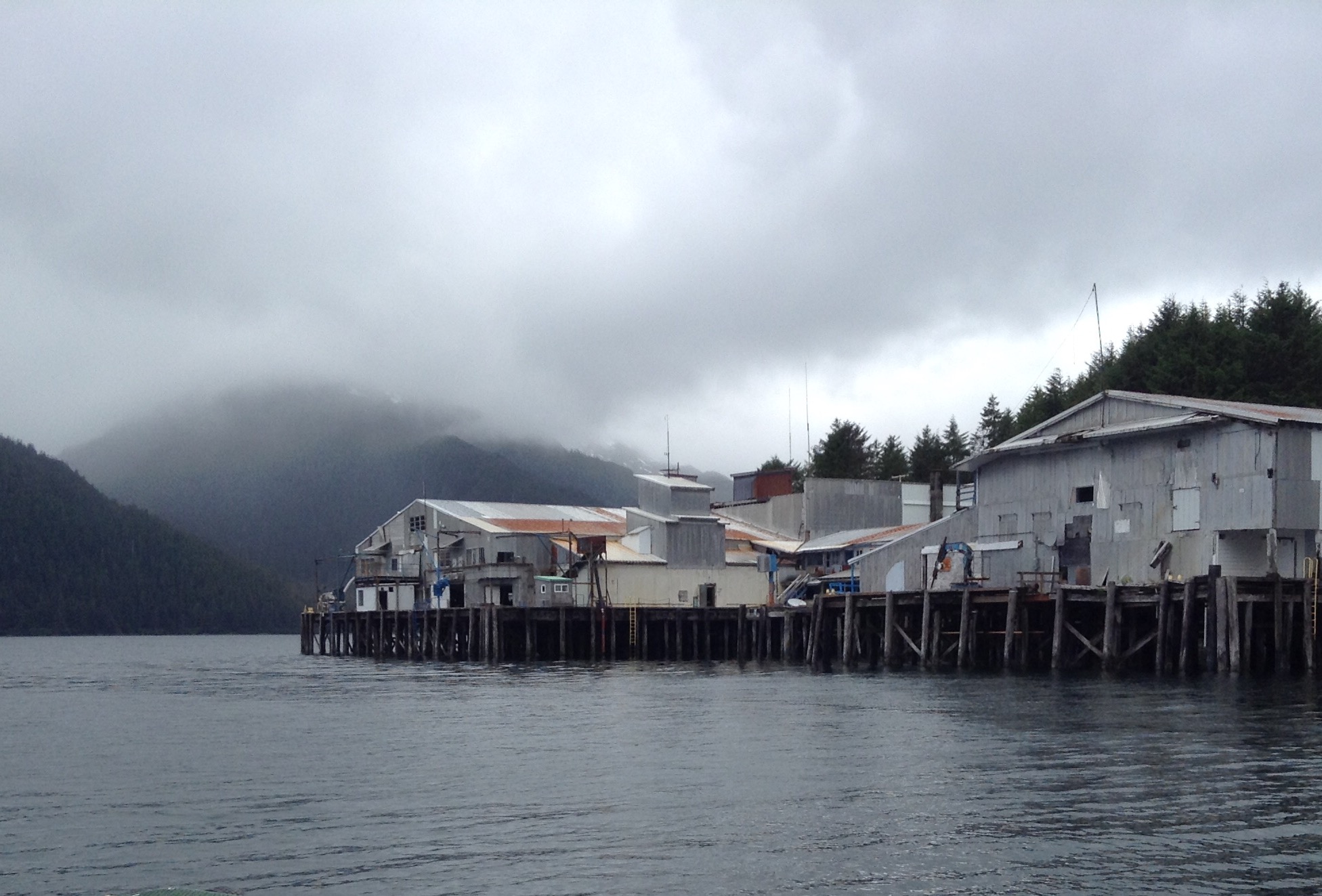
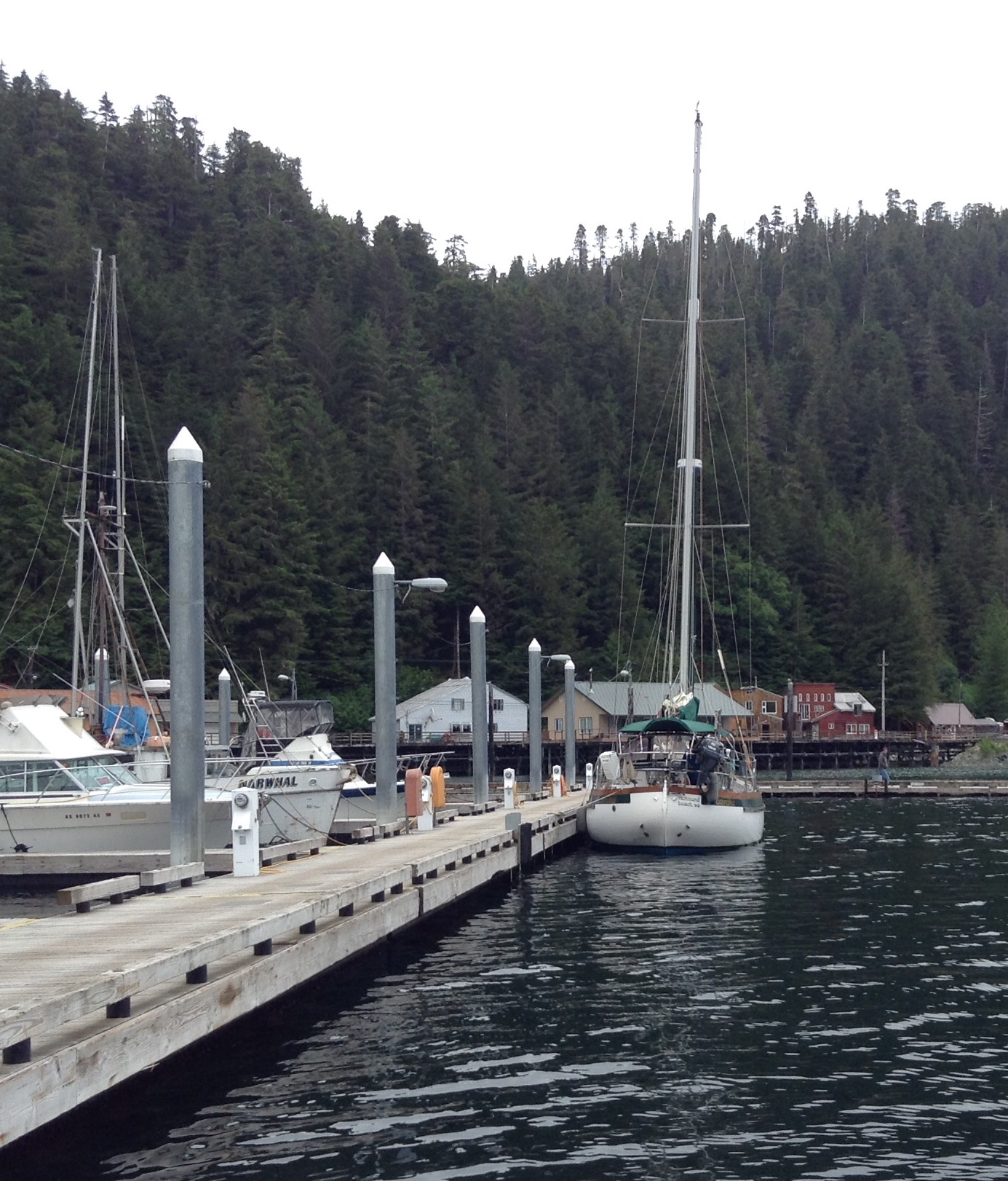
June 11 - Kimshan Cove
Challenging day for navigation, We timed slack low water to enter Lisianski Strait, then ran down the fjord-like channel to the open ocean. Near the mouth we had a choice - a smooth water passage through Lisianski Passage, or a rougher ride in the continental shelf chop. The Douglas book has lots of scary caveats about these passages, though much of that written before boats had GPS chartplotters, and those rocks are charted and don't move much. Seemed like a relatively calm day so we opted for the open water route, only to be kicked by washing-machine waves for a couple hours. Should have taken the inland route.
Soon we could tuck back inside more sheltered waters, threading through Imperial Passage, across Portlock Harbor, then through the unnamed passage east of Lydonia Island, then Surveyor passage to Kimshan Cove for a quiet anchorage in a pretty steep-sided bay. There are almost no signs of humans out here - too early for the fishing fleet, and because these lands are Tongass National Forest, very few homesteaded plats. Saw some otters and seals, but no whales or bears.
June 12 - Sitka Harbor
Our plan was to visit the abandoned gold mining settlement of Chichagof in Khaz Bay, but the steardy downpour discouraged us from wanting to explore, so Dave once again pulled the crabtrap (still zero for the year) and we headed back out to sea via Smooth Passage. Rolly seas today but not as lumpy as yesterday. We motored down to Salisbury Sound, helped slightly by the staysail in light winds, then down Neva and Olga channels to Sitka, arriving late afternoon. On the way I baked corn bread to go with the Dennison's chili for dinner. The freezer, last stocked in Petersburg, is now empty.
Inside the breakwater we tossed the hook over in the NW corner for a quiet night. Joel is here an extra day early before his flight.
June 13 - Eliason Harbor, Sitka
This morning Dave called and scored a slip - 2-9, for the week. We motored in and tied up in the midst of commercial boats readying for the opening on the 15th. The docks are packed, and crews are busy coiling, baiting, running purse seine nets through the booms.
June 14 - Sitka
Dave and I walked with Joel to the airport to say goodbye. This is always hard on us. It is a pure pleasure having him with us, and a small ache inside when he must return to his busy life.
We strolled back into town to download the Seattle Times at the public library, then to the small shop where we met an elderly Tlingit man last year. He was frail then, and on oxygen, so we were not too surprised that he has passed away. The business is now being run by his grandson, or rather the man married to his granddaughter. The young man wants to carry on the traditions, crafting art items from natural tusks, baleen, bones, furs and teeth. BUt he will not be able to pass it further along to his decendents, because he and his wife would only have children less than 1/4 native, the minimum requirement to be able to harvest, craft, and resell these natural items.
We stopped at a fish store to pick up halibut, then rolled home to Baraka. 20k+ day for my fitbit, yah! Sitka is a great walking town.
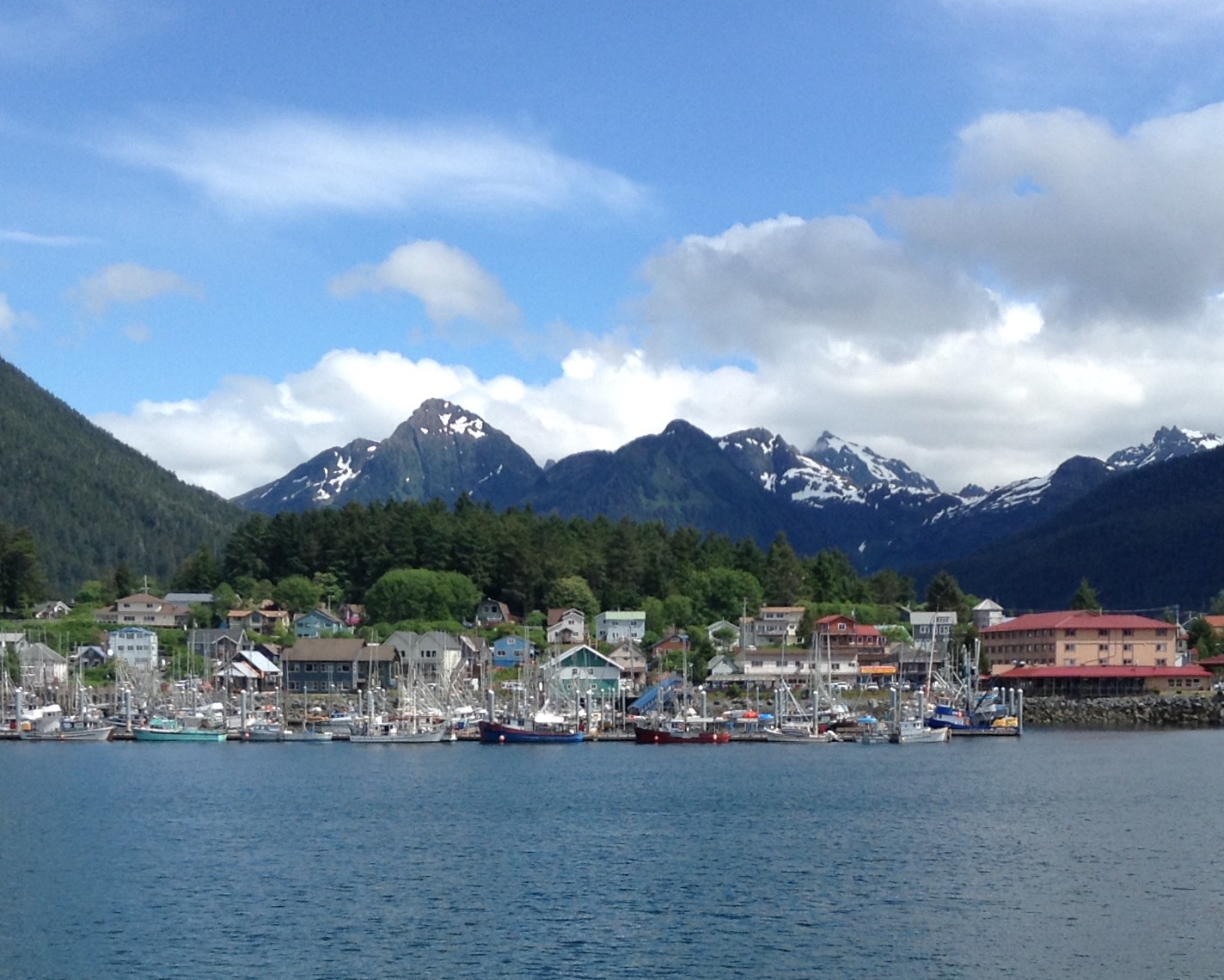
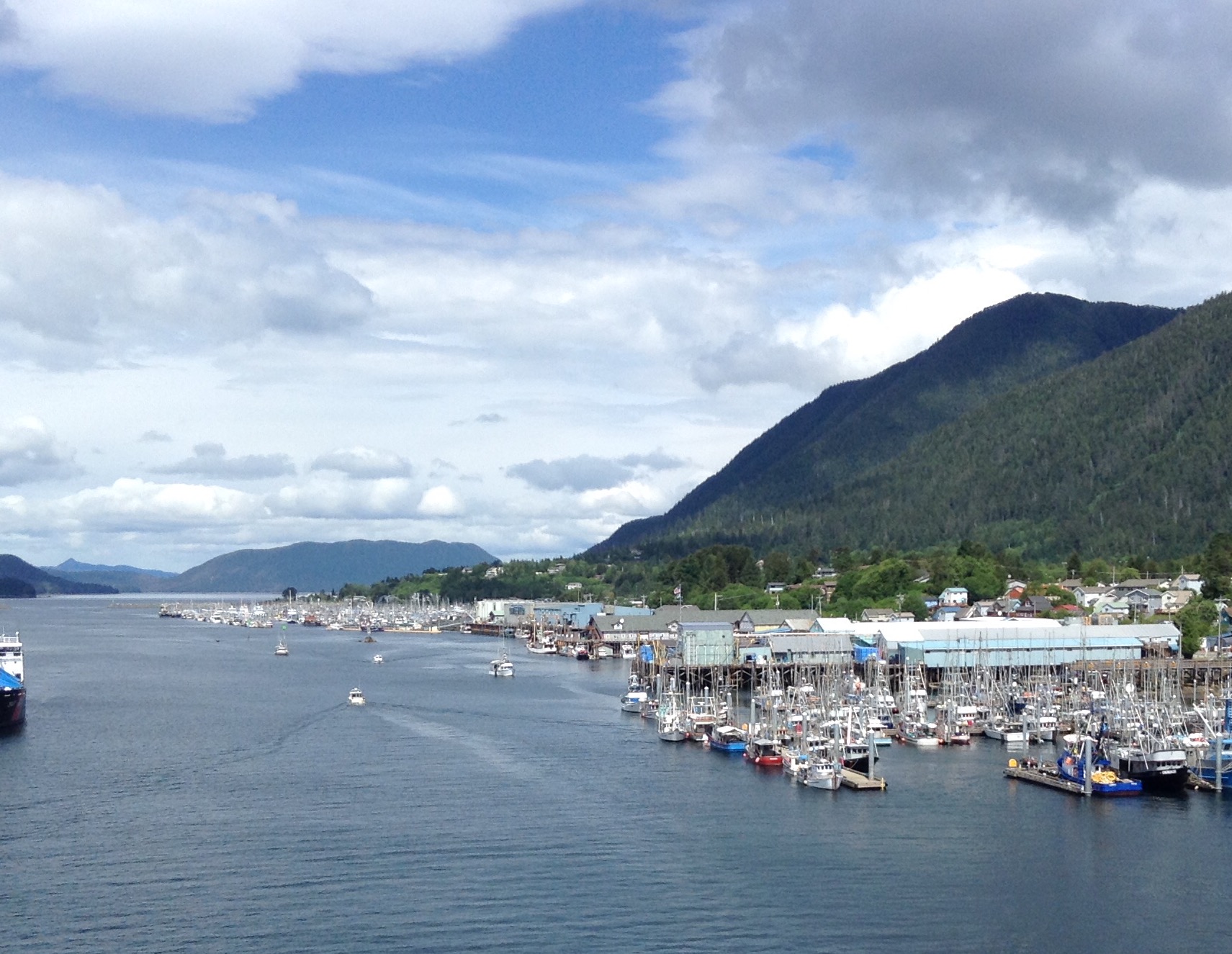
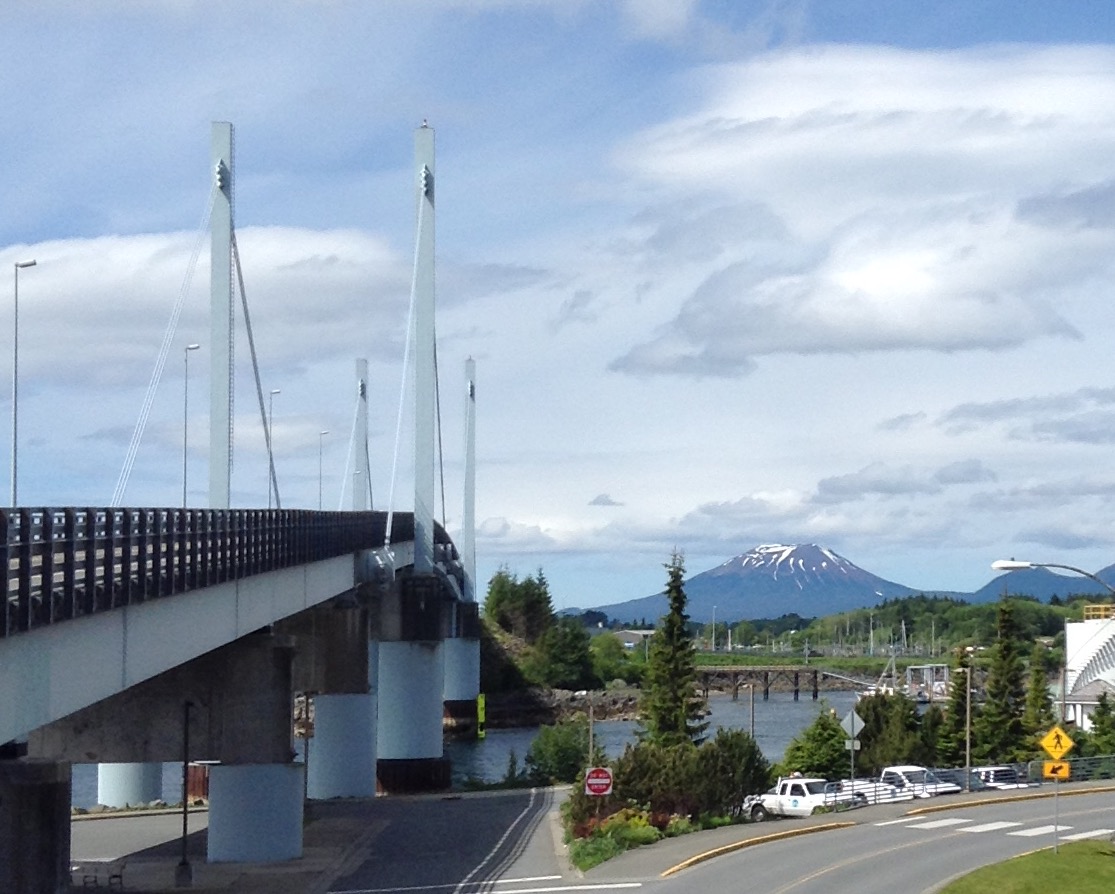
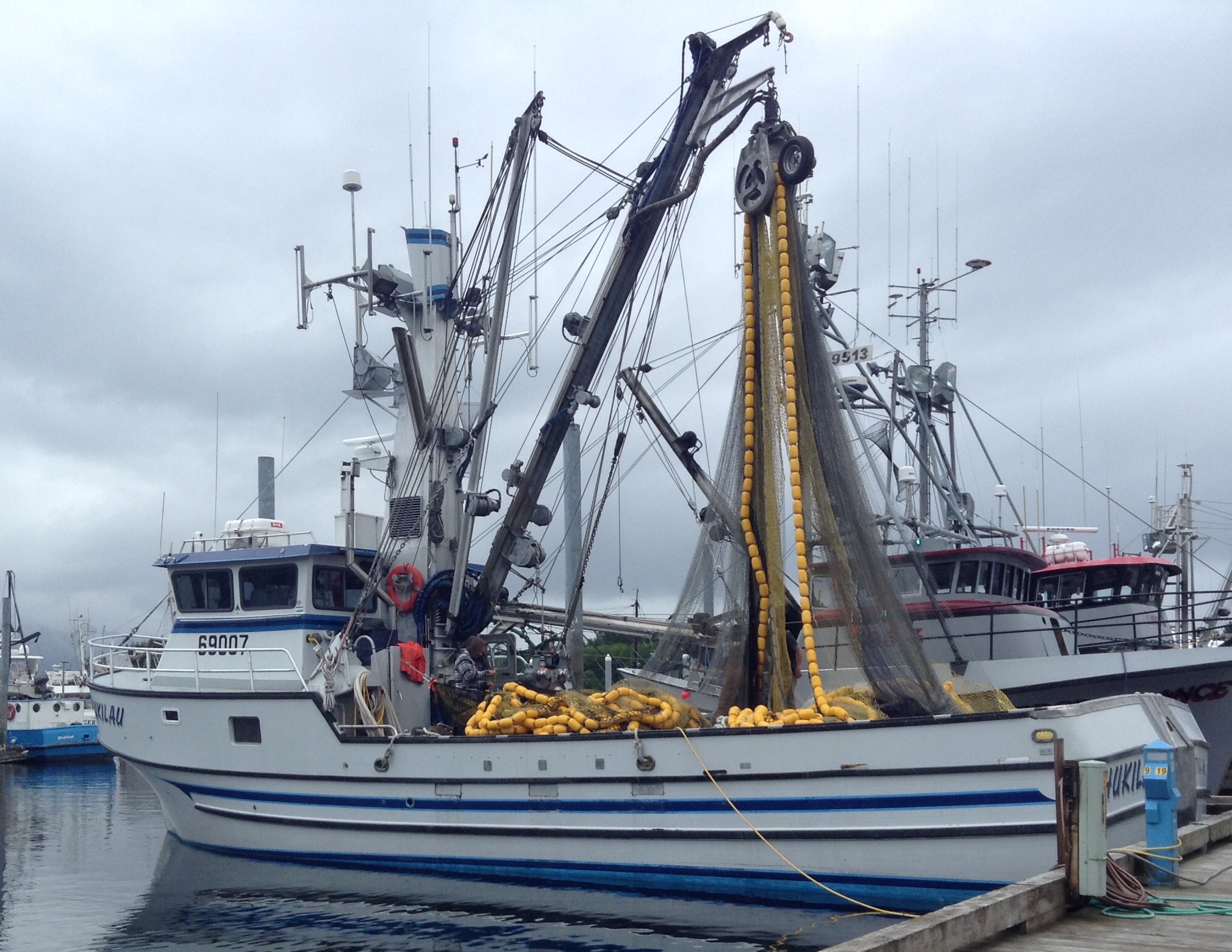
June 19 - Still Sitka
Yesterday we had a rare SE Alaska cloudless day! Mt Edgecombe loomed like a painted Fuji on the western horizon. We interrupted boat projects to walk the totem loop trail south of town, and visit its museum. 18k fitbit day! Back aboard Dave discovered that our propane marinetics solenoid switch has failed - so no halibut dinner. Instead he took apart old corroded components and replaced the switch. The job is still not done. He also gave the outboard a tuneup, replacing the fuel filter and plug. There's still a short list of projects. Weather looks bumpy for a couple days, then better - so we may leave midweek.
We are now thinking or working down the outside of Baranof if the weather seems settled enough. Then up Chatham a bit to some coves on the west side of Kuiu. Then down to Prince of Wales Island. This last is because Dave and I have been reading a series of goofy murder mystery books set in Craig and we are assuming the eccentric characters may be typical for the island. We're in no particular hurry, since we have a month before we need to be in Haida Gwaii for our permit.
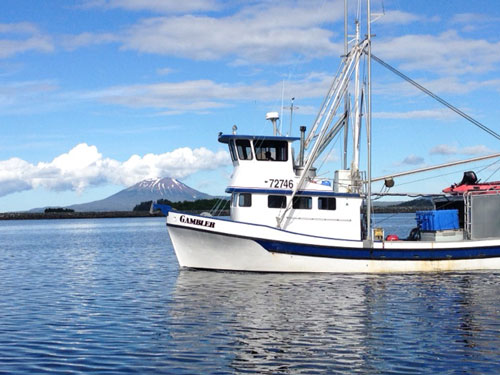
June 20 - Sitka
After a final round of boat and shore chores, we are ready to move along. With encouragement from other boaters, we have decided to head down the outside of Baranof, then Kuiu, then Prince of Wales. Douglass shows lots of interesting anchorages, though this trip will take us into truely remote areas. There's a reason for that - famously soggy weather coupled with an extremely toothy coast. Modern chart plotters make it much safer, but it will still require alert navigation.
So, after final laundry, final showers, final grocery store runs, marina bill paid, and a last trek to the library for internet, we are ready once again to wean ourselves from the joys and conveniences of civilization. Next dock stop will be Craig on the west side of Prince of Wales.
June 21 - Goddard Hot Springs, Baranof
Dave made a final grocery run for more yogurt, then we untied and motored around to the fuel dock where we took on 65 gallons. Dave used his paper-towel-roll dipstick (patent pending) to fill our tanks to the brim. We motored out the breakwater and headed to open water, punctuated by breakers marking numerous reeks and rocks. Pacific rollers lifted our bow, long slow swells. After only 10 miles we threaded our way back inside some islets for a flatwater approach to Goddard. Two boats were in the outer cove, so we followed the Douglass' instructions carefully into the inner bay for a quiet anchorage.
There are hot springs here to explore, and Dave will toss the crabpot over. The teaser sun broke through as we anchored.
June 22 - Baidarka Bay, Rakof Island
Though we beached the dinghy to check out the hot springs, we opted not to use them, not because of lack of appeal in any way, but it looks like it would be impolite to soap up in the standing water tub. Dave found dozens of rib bones on the rocky beach. Maybe brown bears snacked on seal pups.
We pulled anchor, washing off sticky black mud, and made a short 7 mile run to Baidarka Bay, tucked inside Rakof Island. On the way we towed the dinghy in flat water. I stood bow watch as we thread 4 needles, the Kliuchevoi Bay entrance at Goddard, where you make an S curve between a reef and a rock smack in the middle of the entrance, then skinny Louise Narrows, then short and even skinnier First Narrows, and finally through the tricky Rakof entrance to this landlocked bay. Last time bow watch was needed was for tropical coral! This area is remote and uninhabited, and the rocky bottom unforgiving.
A baidarka is a traditional sealskin vessel similar to a kayak. This landlocked bay with many rocky islets would be great to explore by kayak.
We've slowed the pace way down. From here to Craig we plan to make lots of stops. Time to stop and smell the seaweed.
June 23 - Still Harbor, Whale Bay, Baranof
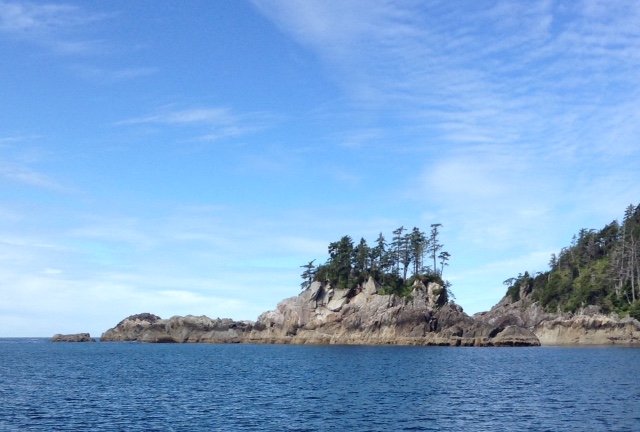
We woke to rare sunny day. Dave listened to weather on the VHF, 25 knots coming tonight. We elected to skip a planned stop at Yamani Cove to head for the better weather anchorage at Still Harbor. Leaving Sitka, our knotmeter wasn't reading, despite Dave's efforts from the dock with a scrubbrush. Cause is often a bit of kelp. Underway today we could seeing it trying, registering low numbers.
Flat seas today in the Gulf of Alaska! The snow topped shore topography looms steeply above the tortured shoreline, where clean-swept granite 100 feet up testifies to the roughness of these waters. At the entrance to Still, dozens of sea otters bobbed in the kelp beds, and a seal mom and pup watched us glide by.
We anchored at the head of the bay, then took the dinghy back to visit the otters. They bobbed around us but wouldn't approach.
June 24 - Still at Still
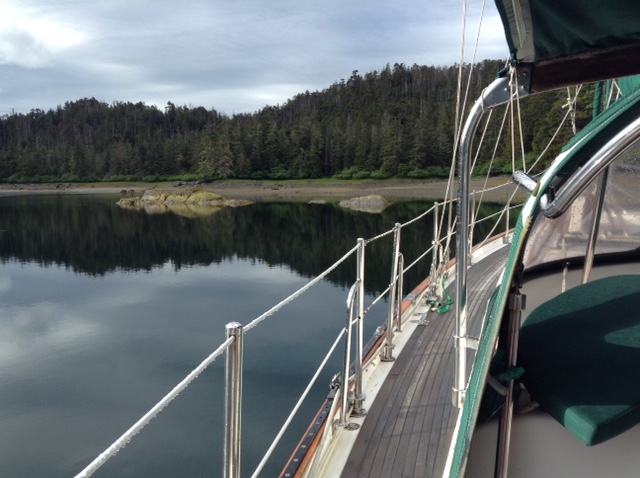
Weather forecast this morning is small craft advisory, 20 knots, not bad but would be a bash on our nose, so we opted to remain here one more night. We get weather ok via VHF. There must be repeater stations.
This morning at low tide we discovered several drying large rocky patches just 100 feet from our eggshell hull, yikes. They are not on our charts. Dave took the dinghy over to get coordinates:
56 32.439 N 135 0.942 W
56 32.440 N 135 0.950 W
56 32.442 N 135 0.964 W
We are anchored just out of range, but assumed this anchorage was well charted.
Tucked inside here there is no sign of winds outside. Boat project day, coupled with some reading. Joel loaned me Barbarian Days, a beautifully written biography of an obsessive surfer. Plus I finished The Three Body Problem, sci-fi with VR, another Joel recommendation.
Crabpot still empty. Where are the dungeness? Maybe too many otters around.
June 25 - Reanne's Terror and Reanne's Relief, Baranof
Left Still this morning. The bay was glassy calm, with a mirror reflection of the shoreline. Waved a last goodbye to the otters at the entrance, then ran down the coast a couple hours against a slowly building breeze. We ducked into the aptly named west entrance to this bay, a narrow opening fringed by breakers. Reanne is Reanne Douglass, co-author of the Alaska cruiser's bible for this area. She survived a southern ocean pitchpole so I'm guessing nothing much could cause her terror.
Once inside, we turned a corner into a gorgeous anteroom, and left the ocean swell behind. Then another couple turns took us into a spectacular quarry-like bay, with vertical sides. Beautiful. Again we have the anchorage to ourselves, plus a few otters and seals.
June 26 -Toledo Harbor, SE Baranof
Weather is clocking to the NW today, with a bit more wind and seas. We said goodbye to Reanne's, one of the prettiest Alaskan anchorages, and zipped out the south entrance. Dave pulled out the jib, and we motorsailed in somewhat rocking seas to the south point of Baranof, where we tucked inside Wooden Island, a steep-to islet crowned by a thatch of trees. A couple humpbacks blew by. High on the cliff, above the surf line, a large colony of sea lions lazed. We turned into Chatham Strait, out of the seas but not out of the gusting wind. Soon we could tuck into Port Armstrong, our planned anchorage, only to find a fish farm parked there. It looked like we could shelter instead at the head of the bay, but decided to carry on.
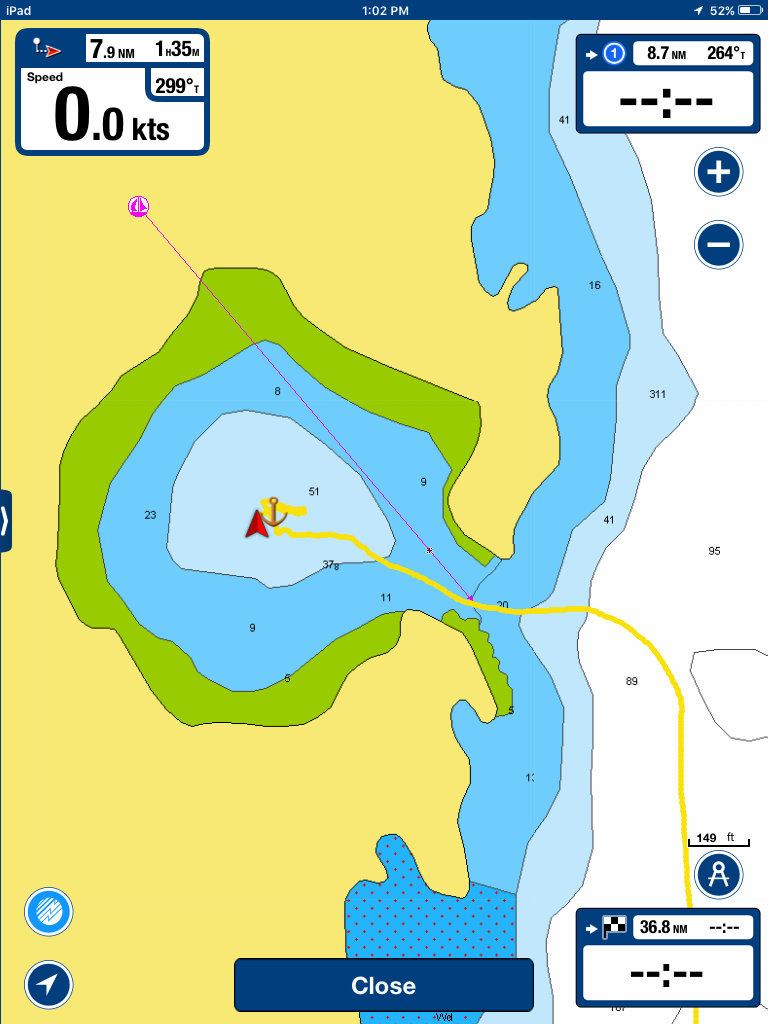
Just 5 miles further, we turned into tiny Toledo, a nearly round cove just 250 yards in diameter. The entrance is narrow and lined with bullkelp patches. We dropped the hook in the center and have the place to ourselves. There's a waterfall in the corner, and a flock of black, white and red diving ducks.
It is full summer now here in SE Alaska, but we continue in 4 layers, hats and gloves, drink hot chocolate in the cockpit, and fire up the heater at night.
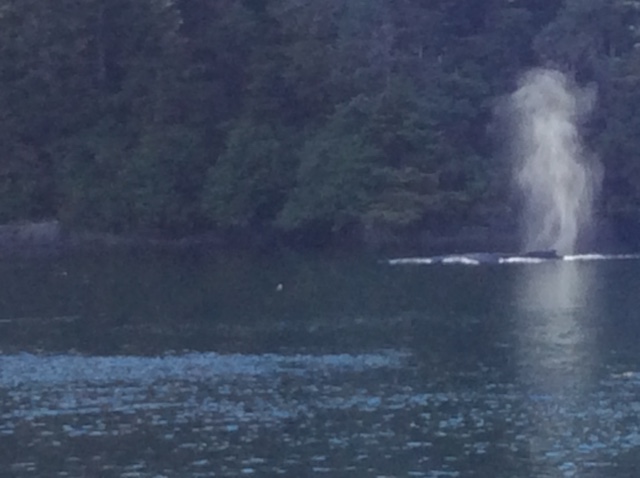
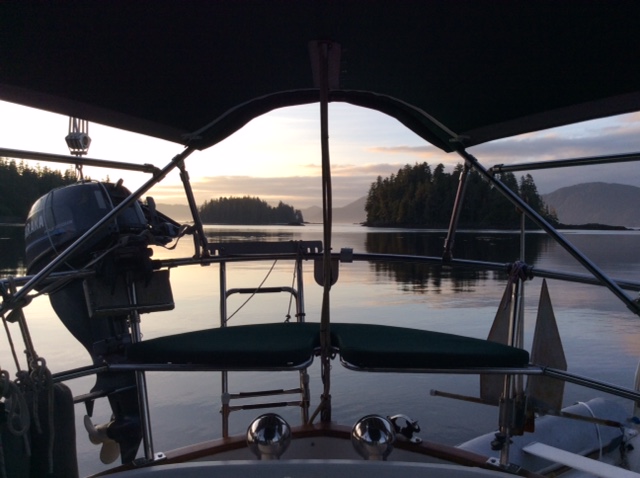
June 27 - Troller Islands, Explorer Basin, Kuiu Island
Overnight our tiny bathtub bay at Toledo got even smaller as the tide went out. Crabpot had a small rockfish, 0 crabs. We crossed lower Chatham in fine calm weather and tucked into Explorer Basin, then between the Troller Islands amongst bullkelp undulating in the current. The anchor growled over rock when we set it. Just behind us is a half fathom shoal. Dave rowed over with the dinghy depth sounder to see just how close. Sun out today! But still in 4 layers and making hot chocolate to stay warm. We are both longing for hot showers. I thought we'd have to wait for Craig but Dave found a bay at the north end of Pr of Wales that claims showers! With no water pressure this year, we are taking basin baths.
I rowed across to a narrow passage, followed by a seal that lurked nearly, stalking me in ominous serpantine paths, popping up ever closer. He followed me inside the swirling passage. I thought about bonking him with an oar if he tried to board the dinghy. Rowing back from the little passage I heard the blow of a whale. He was only 30 feet away! These humpbacks move in majestic slow-mo. He and a buddy worked down our anchorage to Explorer Basin. During our cockpit dinner a couple more blew by. Seems we are parked in their parade route.
Still no cell coverage out here on the fringes... These are lovely anchorages but civilization is starting to beckon.
June 28 - Calder Bay, near El Capitan on Prince of Wales
Rare flatwater day in the straits, so we tooted all the way down Kuiu, past Cape Decision and into Sumner Strait, then headed across to Calder Bay, situated just north of Middle Island in Shakan Bay. Long day motor sailing, with the main up but offering small help in light wind. Along Kuiu we saw lots of blowing humpbacks near the shores, then at the south end began seeing fishing boats, trollers and sport boats after a long week of almost nothing.
Tomorrow we will run the gauntlet of El Capitan, a long dredged canal down Prince of Wales.
June 29 - Kahli Cove, Prince of Wales
The depth sounder is misbehaving, sporadic readings. Dave cleaned and rebed all the connections, swapped out the main module to no avail. This morning it seemed that our small inverter may be causing interference, especially when the computer is plugged in.
We threw the dinghy in the water, towing it for better visibility, and headed for El Capitan, a half-dredged, half-natural waterway that forms a long elbow through NW Pr of Wales. Our depth sounder (behaving!) showed about 12 feet minimum in the cuts. At one point our track showed us over dry land. At low tide the ditch seemed barely wide enough for Baraka. Glad we didn't meet any oncoming boats. Spotted one black bear on the shoreline that ran into the woods when Dave called "hey, bear". Arriving at Kahli Cove, a large raft of otters seemed to be holding a convention.
June 30 - Craig, Prince of Wales
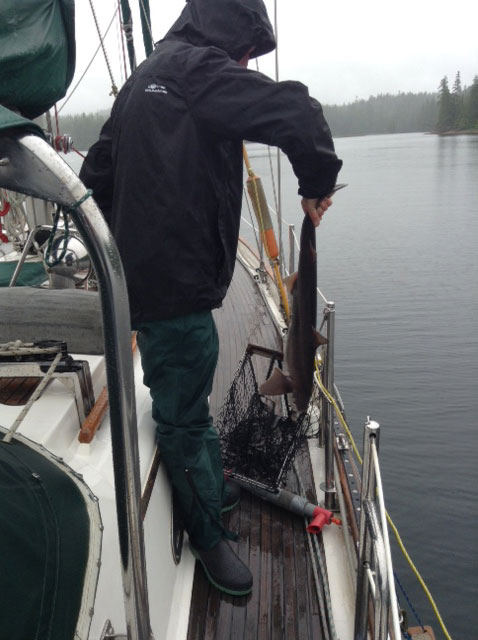
Woke to steady drizzle. Dave pulled the crabpot, finally a catch! The catch was a feisty mud shark. Underway, I made Dave toss the bait - chunks of halibut - that have been ripening in the lazarette for several weeks. The smell is terrific.
We worked through 2 narrows, making good time with a favorable current, so opted to carry on to Craig.
July 1 - Craig
We scored a good moorage at the northern end of the long dock in the north basin, just inside the breakwater provided by a large barge, stacked with containers that are rented to commercial fishermen to store gear. We have water and power, though no internet, so we hike to the library or pizza place. Best of all we got long, hot showers, long overdue! We turned on the AC fridge but the pump squealed, so turned if off. Dave discovered the seawater intake is not drawing, and blasted it with the dock water hose. That seems to have fixed that one.
We will park here a few days and enjoy Craig, maybe even rent a car to explore.
July 6 - Craig
We are on the north end of the long dock at Craig's north harbor, still tucked inside the breakwater barge. "Downtown Craig" is a peninsula that may have been an islet, now connected to "suburban Craig" by an isthmus. North of the isthmus is the commercial and transient harbor. South of it is the small and sport fishing boat harbor.
The town woke up for July 4th with lots of random fireworks and a community celebration in a park.
We are still here because Dave decided to rebuild our freshwater pressure system so we could have hot water. First step was yanking out the old copper piping, which took 2 days since it was inaccessible, apparently installed before the floor was laid. We needed it out to make room for the replacement hose, which had to squeeze through small openings in bulkheads. To reach part of it, Dave has cut holes in floors in the bottom of 2 lockers.
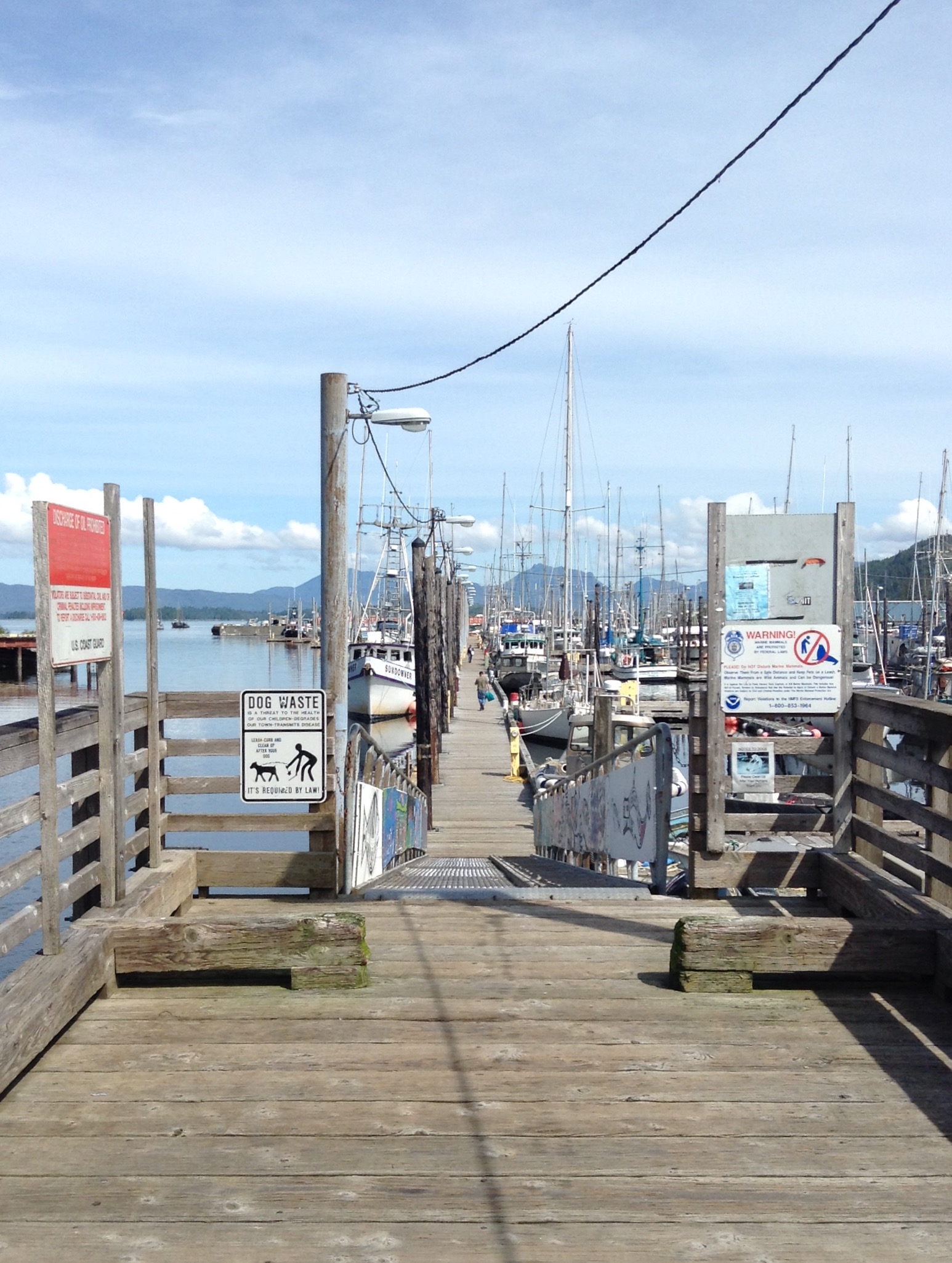
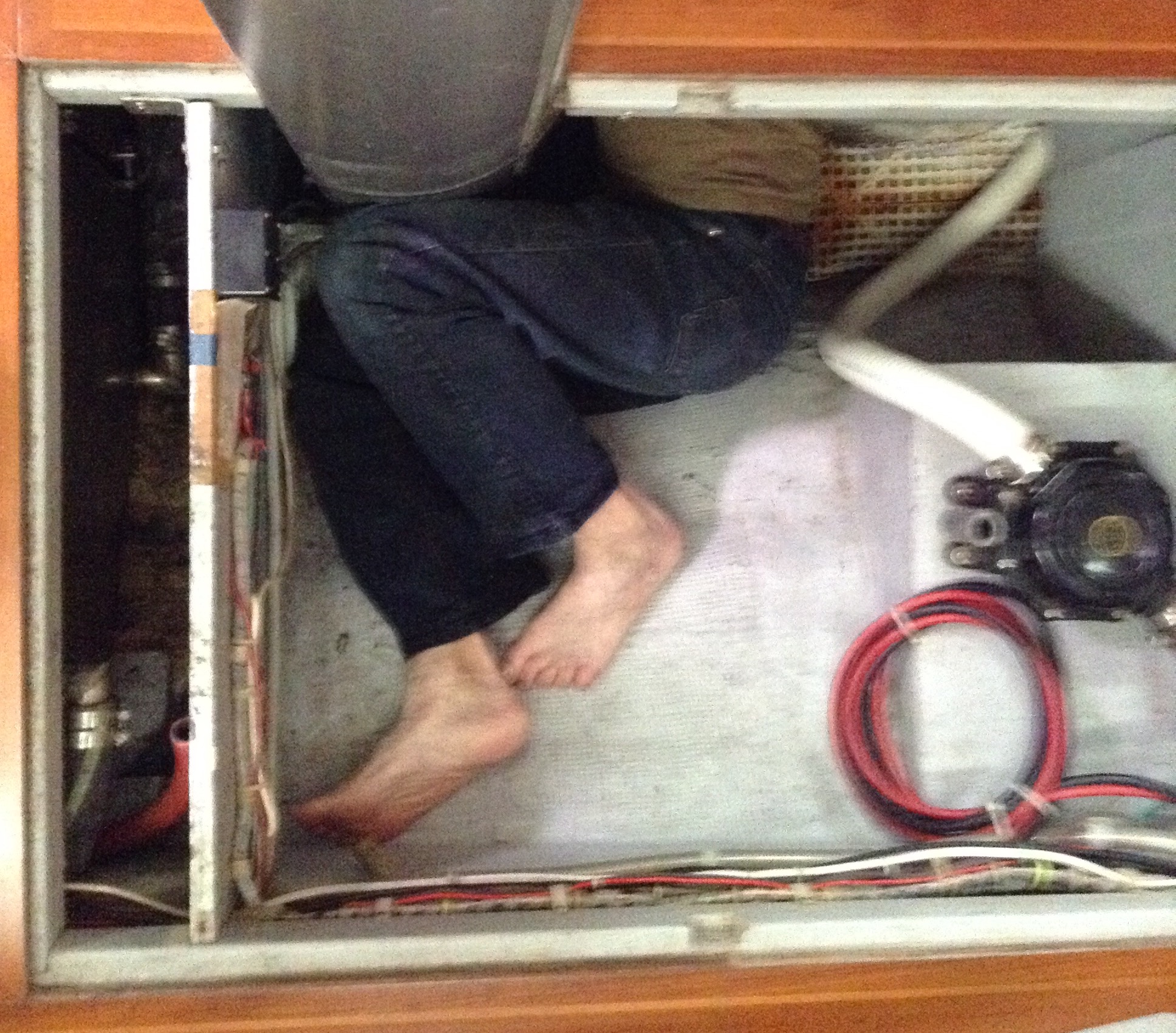
Another day was spent running messenger lines, then pulling the hoses through. Today Dave is installing all the connection fittings. Our water sytem is complex, 2 sinks and 2 showers (one in the cockpit), a pressure pump and pressure tank, a hotwater tank that can be heated by the engine, AC system, or the furnace, two water tanks and the watermaker system which has a freshwater flush. Dave has several diagrams of all this. We had talked about delaying this project until we are home again, since it requires that all the storage normally under the beds, sinks and main cabin floor have to be pulled out and stored somewhere. There's not much room left, plus each day we pull out big mattress and lean it upright in the main passageway.
It will be worth all this to again have hot water for showers. At least we tell ourselves so. It terms of sheer difficulty Dave compares this effort to the watermaker install, equally complex and inaccessible. I arranged a car rental for tomorrow to give ourselves a holiday from the boat. Time to explore a bit of Prince of Wales.
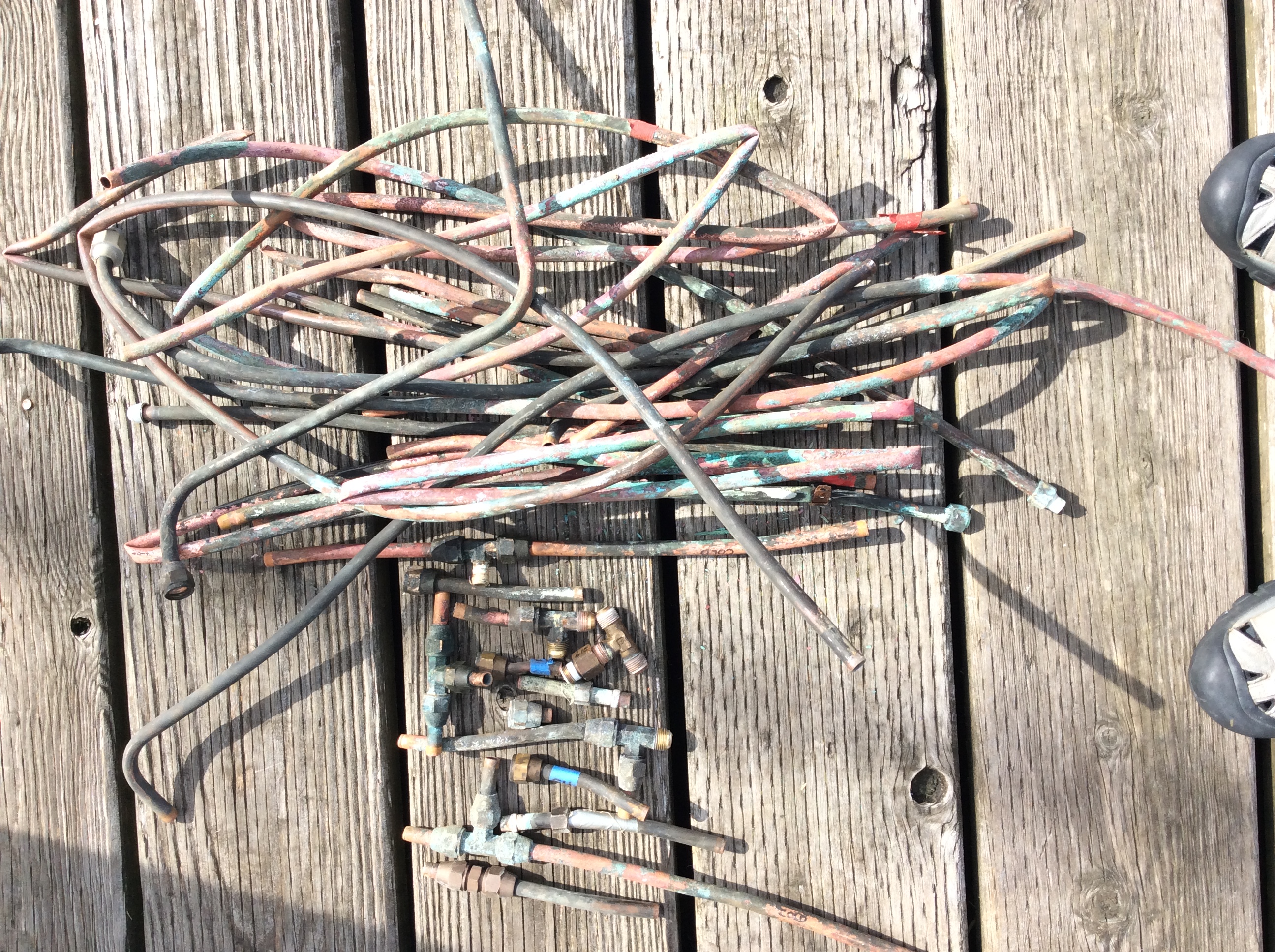
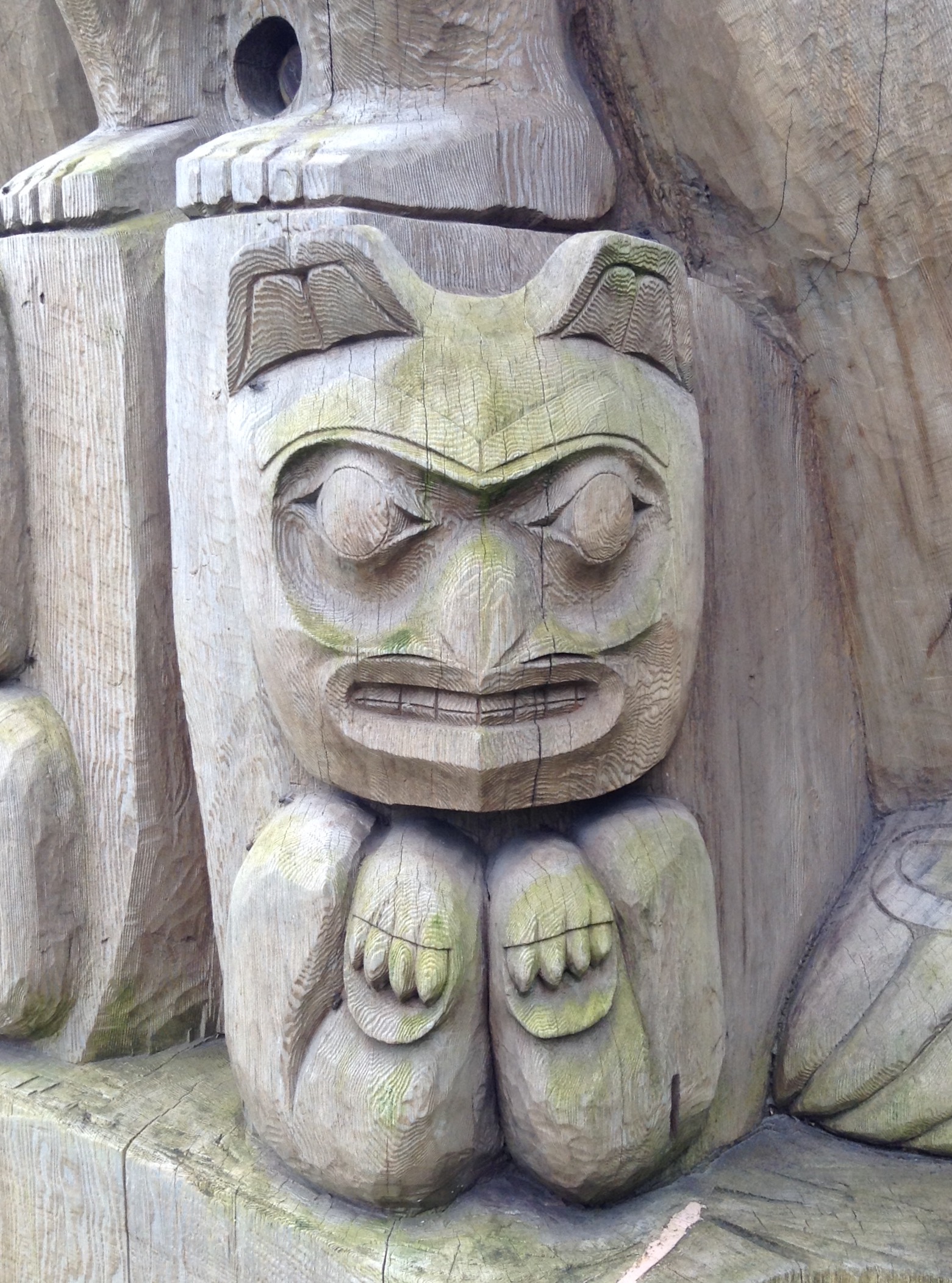
July 7 - Craig
The big replumbing project is done, and successful! We pressurized the system and found 4 leaking joints, which Dave quickly fixed, bled the system, then turned on the hot water tank. So far it is holding pressure. Then came the job of putting the boat back together, and putting all the tools away. We are very nearly back to normal.
We did rent a car for a day - a huge Suburban since that was what they allowed off the paved roads. We tootled up to Klawock to visit the impressive totem park, then to Thorne Bay for lunch, then out to Kasaan for Haida totems and the restored longhouse, where the watchman was one of the carver/restorers. This longhouse was restored once before, in the 1930s, and may be the last original one. Compared to the new longhouse at Barlett Cove, this one is plain outside, with 3 very old poles inside. Kasaan is reached by an hour-long twisty gravel road. Once there, a nice forest trail winds 3/4 of a mile to the longhouse. They don't get much tourism. Most visitors to Prince of Wales have come here to fish.
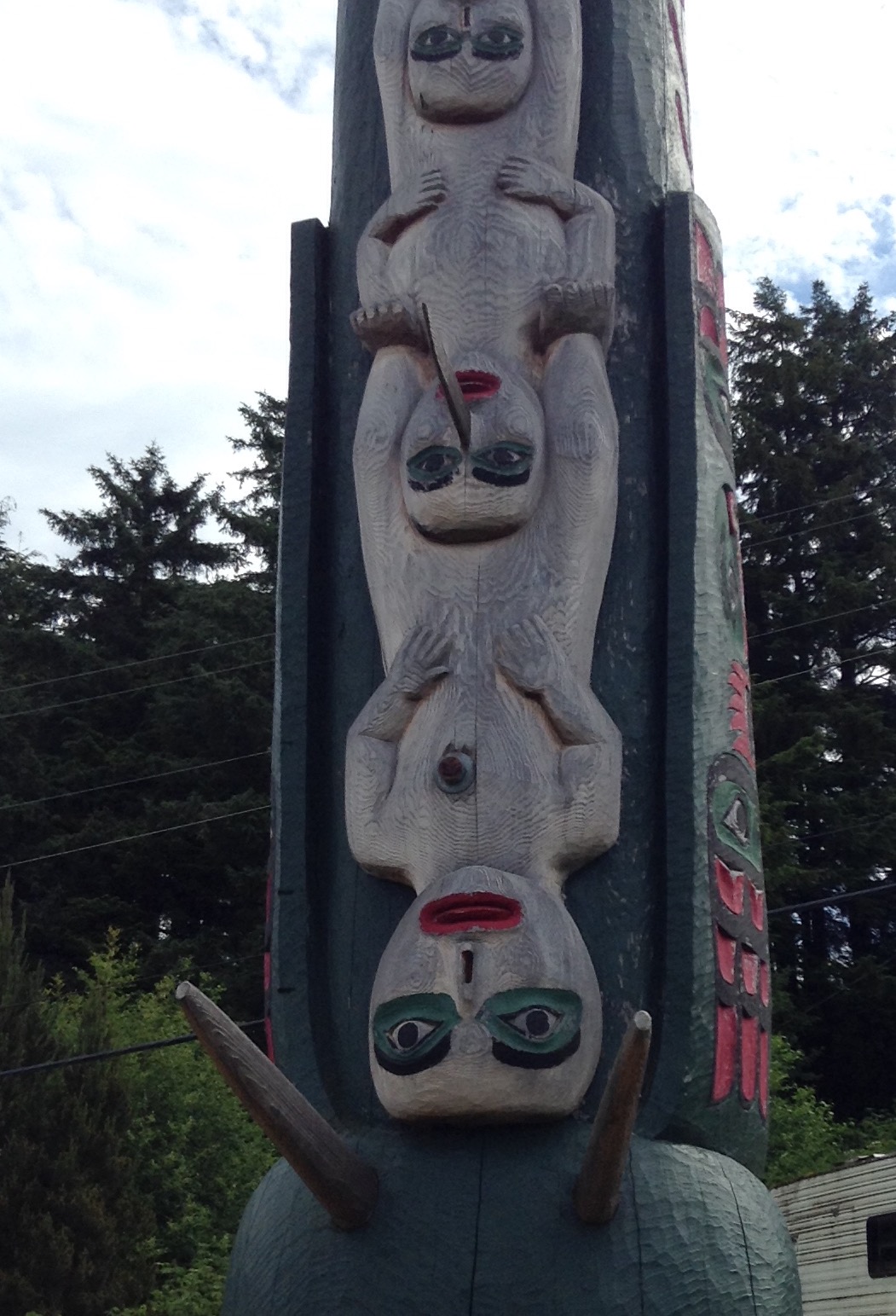
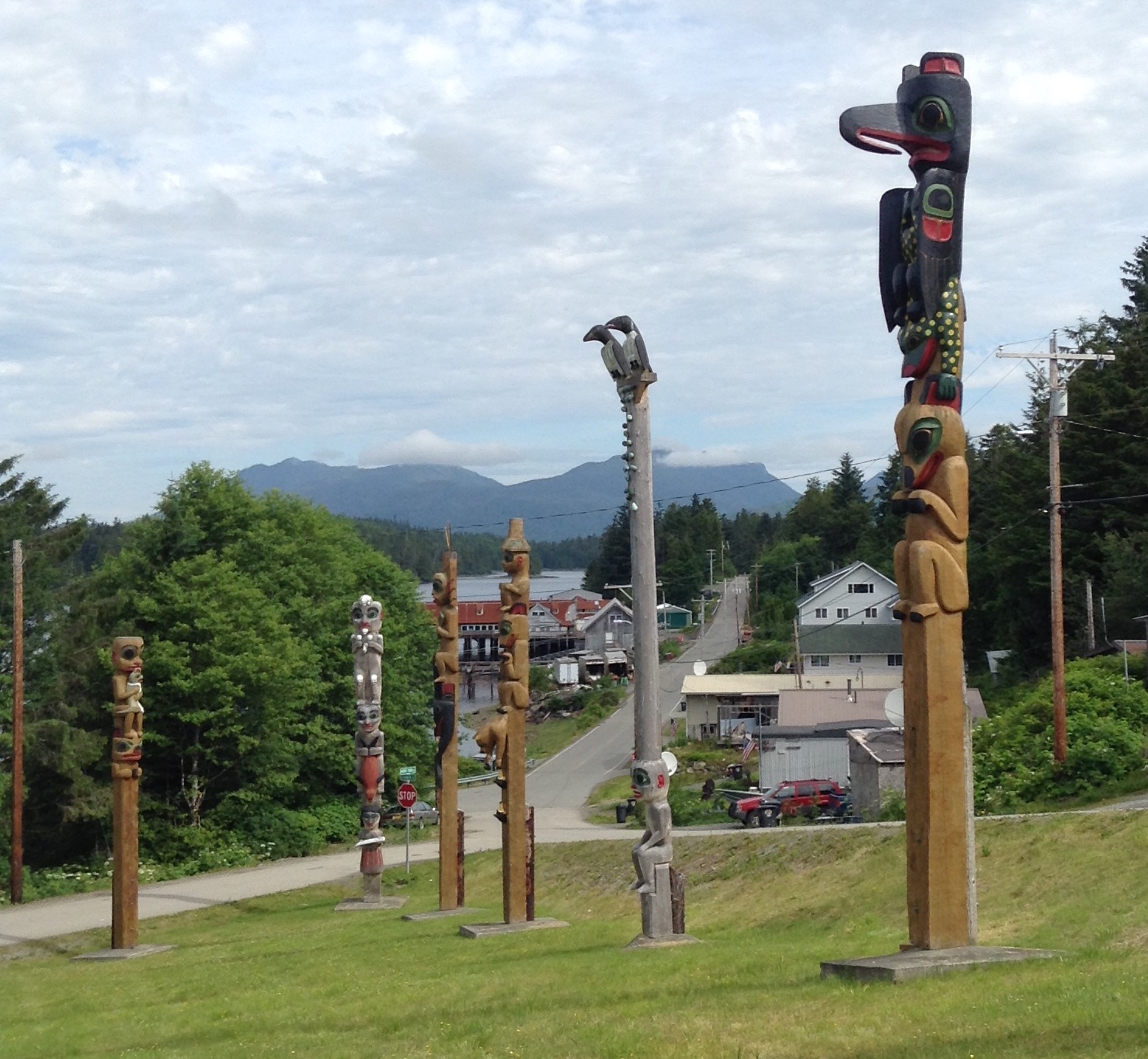
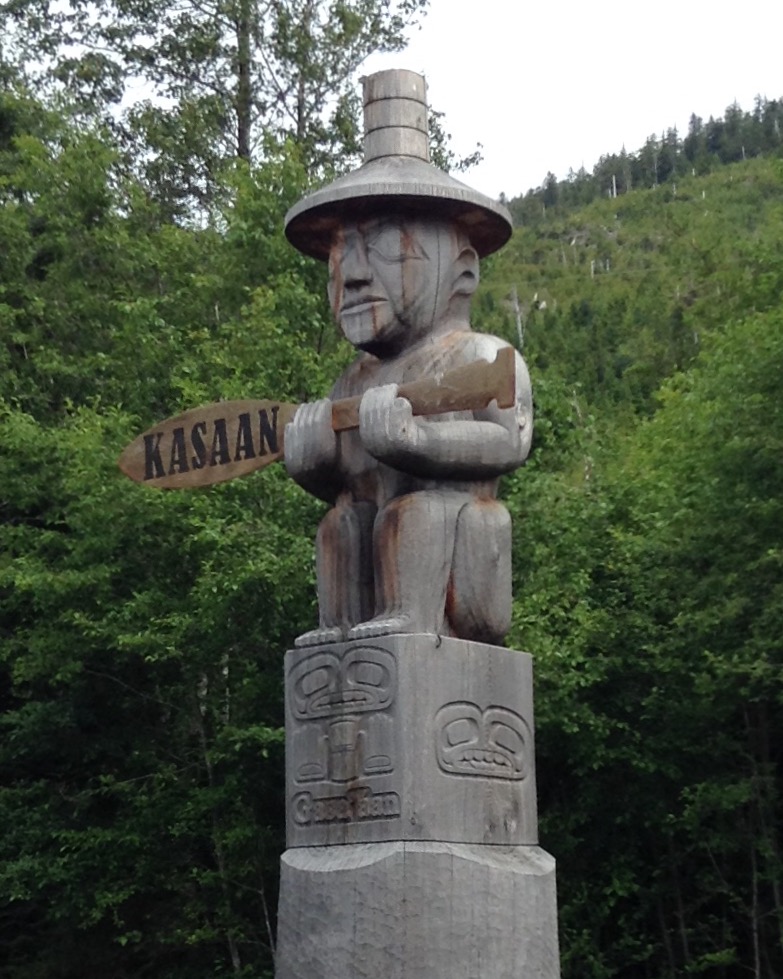
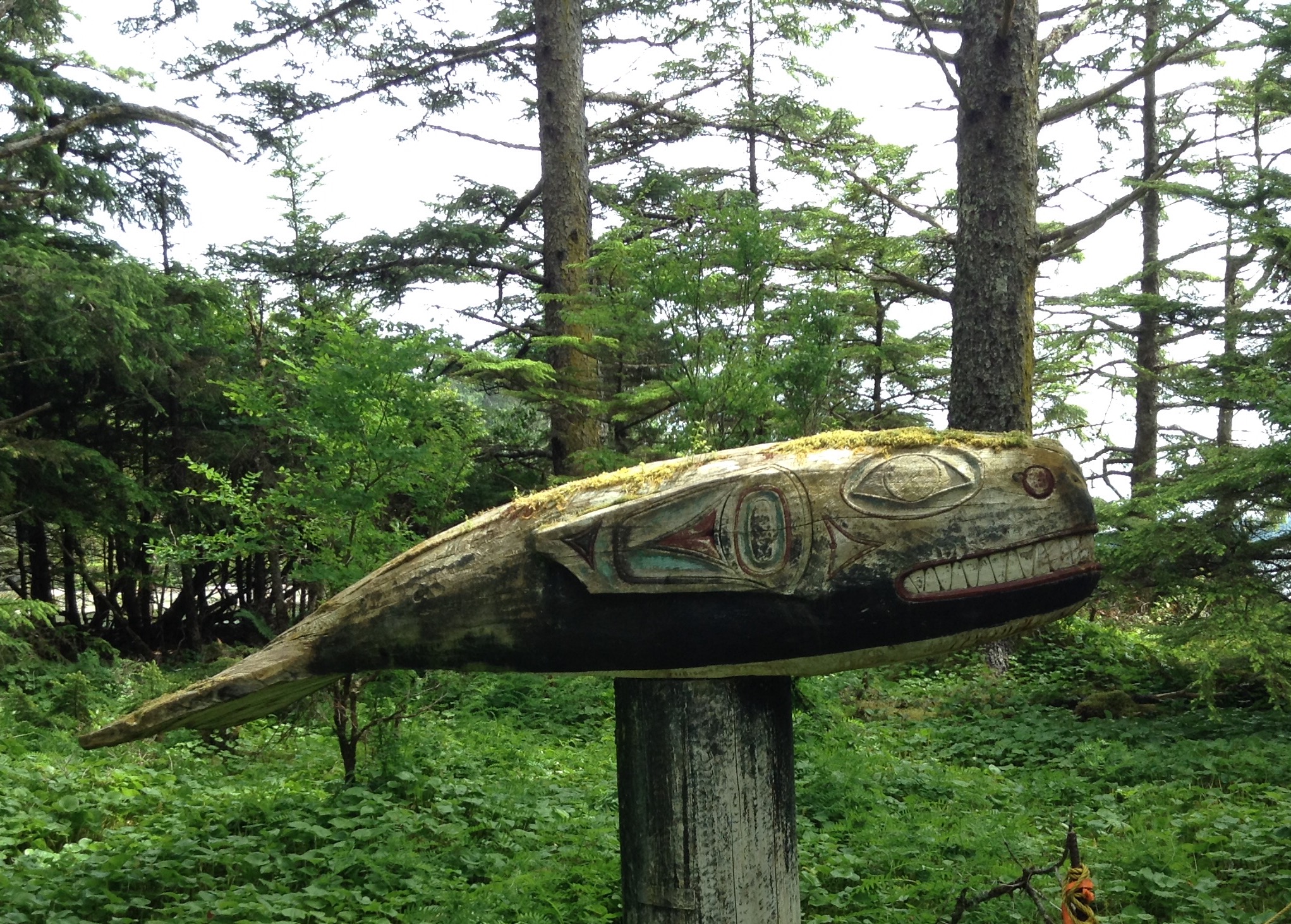
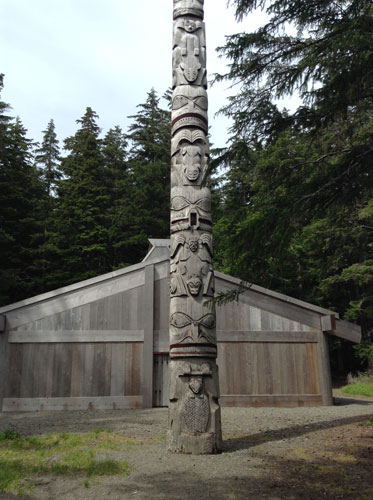
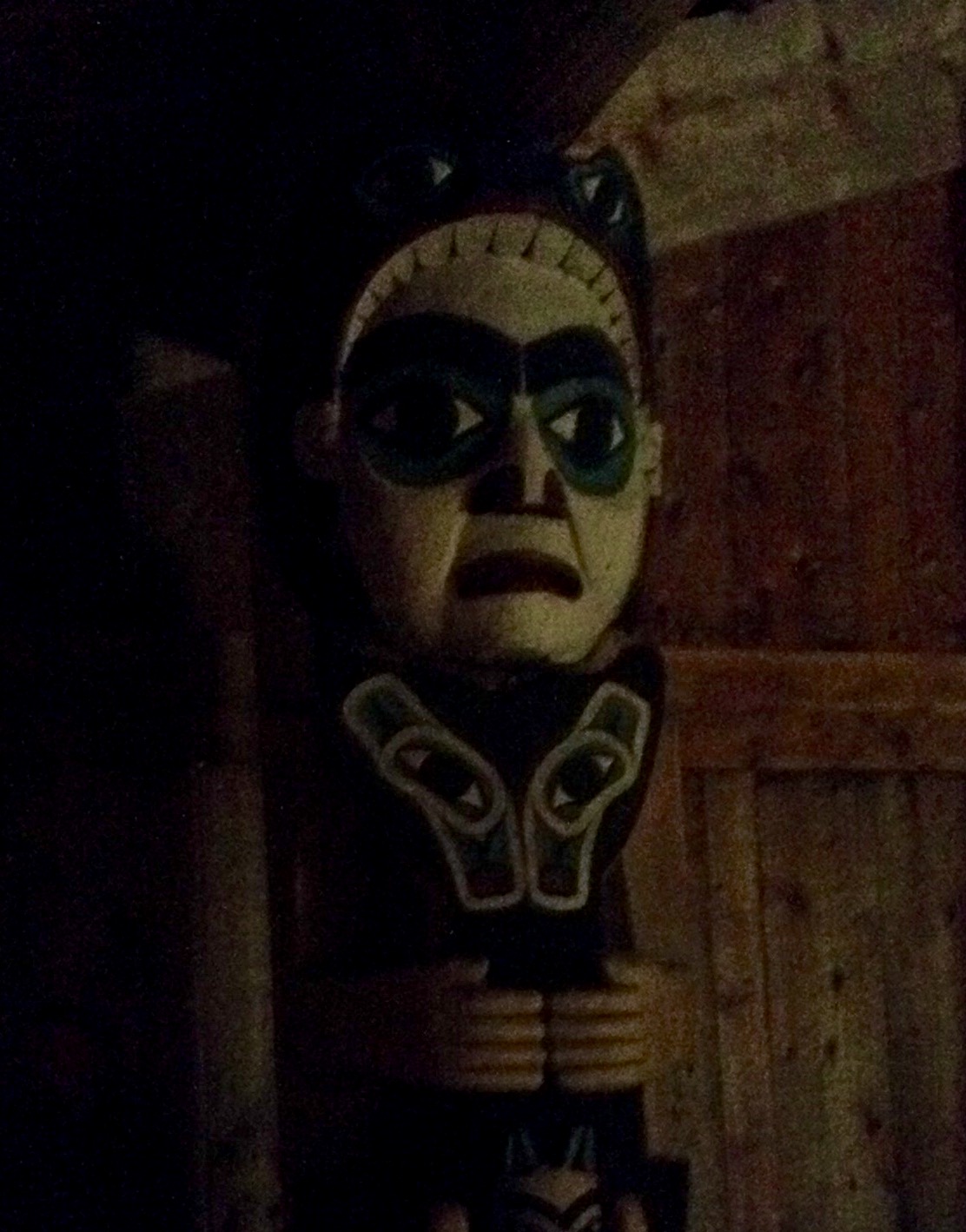
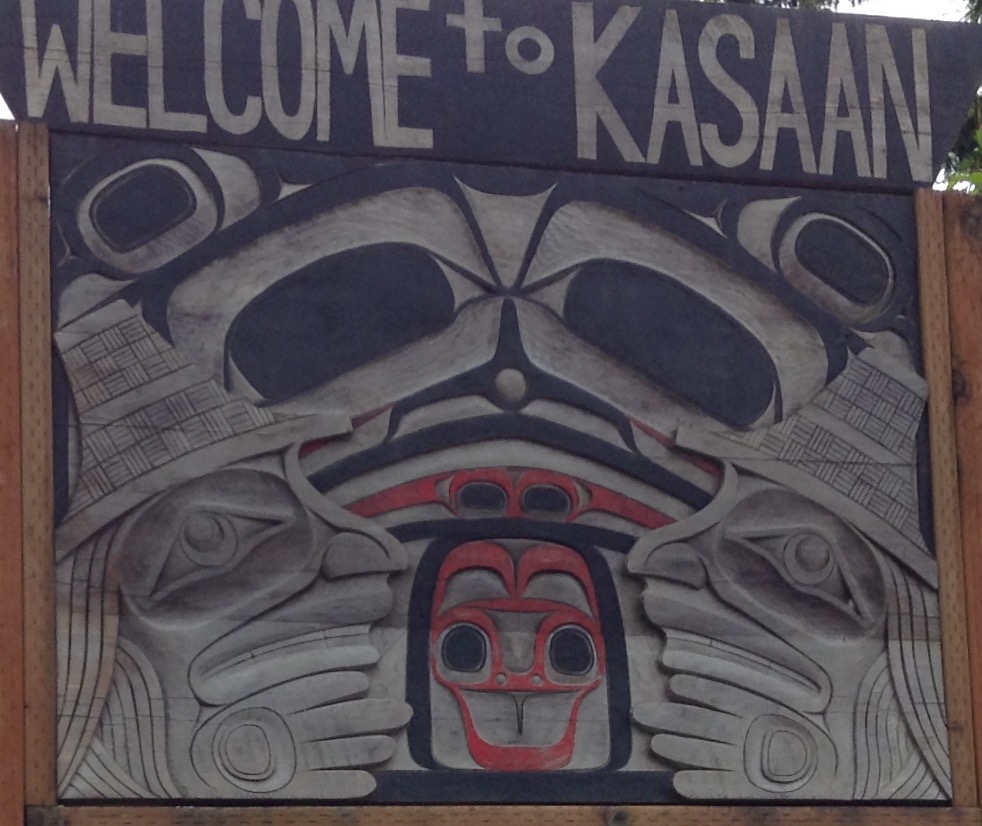
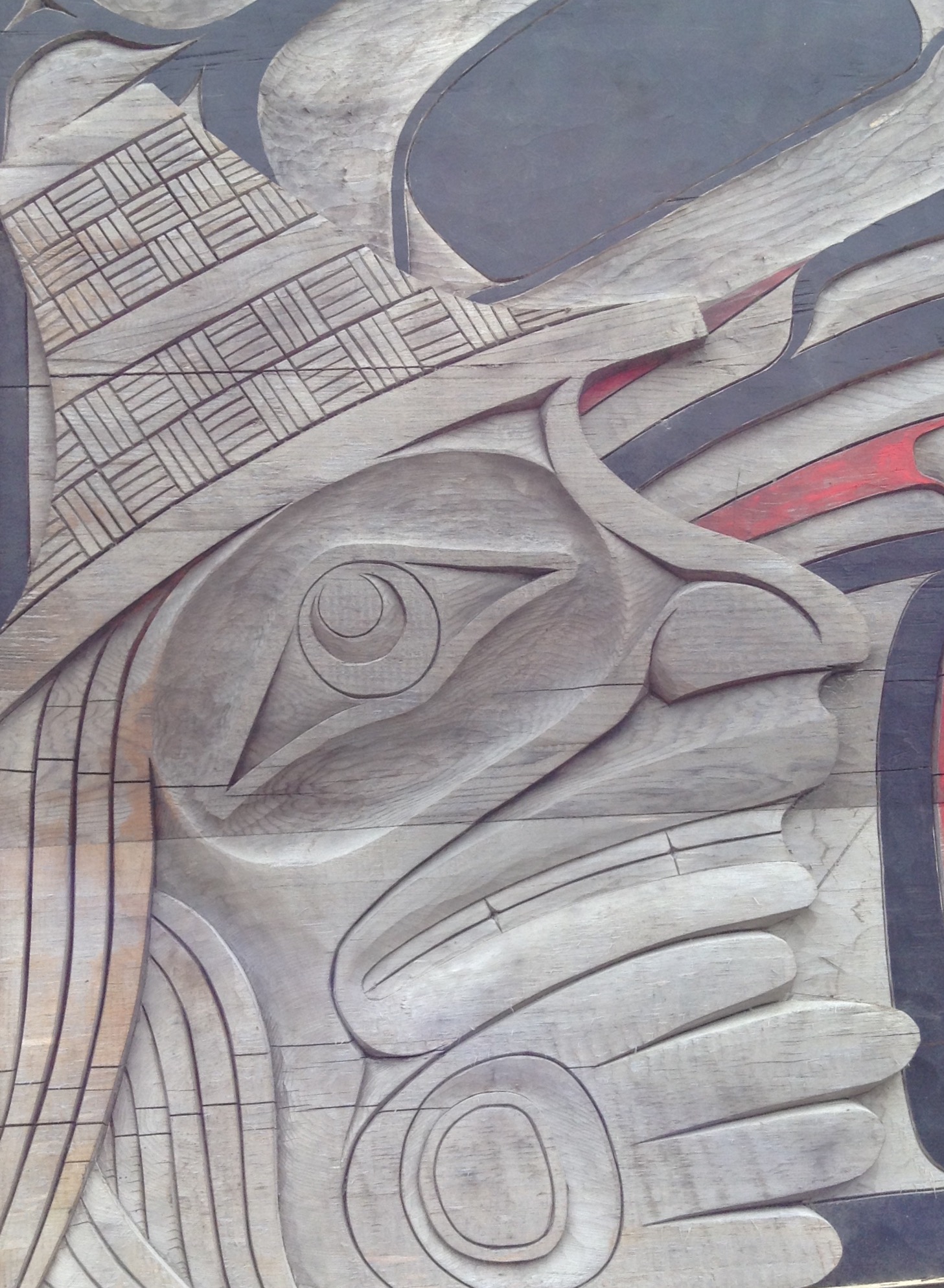
We carried on to Coffman Cove. This island is enormous, very scenic with glaciated mountains and many black-tailed deer. Prince of Wales has been extensively logged, with 2nd growth underway in some areas, and other areas clear cut bare.
July 8 - Craig
We are finally ready to move on. When we paid up moorage, the harbormaster gave us the monthly rate, since that was cheaper than the daily rate after 8 days! We did final laundry, will do a grocery run, final shore showers, final topping up the water tanks, then tomorrow morning carry on. Southward ho!
We plan to stop at Hydaburg, another Haida settlement, to see one more totem park, then work our way to the bottom of Prince of Wales to cross to Prince Rupert and clear into Canada. If we dawdle, it could be as much as a week to PR, or as little as 3-4 days. We are running a little behind, as we have a permit for Haida Gwaii the last 2 weeks of July, so it is time to pick up our skirts a bit.
July 9 - Port Refugio, Suemez Island
We are tucked behind an unnamed islet in Port Refugio after a squally run down from Craig. Setting the anchor, we spotted 2 black bears on the beach, and 2 circling eagles overhead. Nice to be underway again, though we are layered up for the chill, and Dave fires up our furnace. July in Alaska!
July 10 - Hydaburg
Woke to rare sunshine. Mostly cloudy, but every so often enough rays to cast a shadow. 2 humpbacks trolled through our anchorage, hugging the shoreline. 6 frisky black-tailed deer played on the beach, then grazed in the grass. 3 more, inluding a fawn, graze on the unnamed island we are tucked behind. Dave rowed over to retrieve the crabpots (no joy). A seal or sealion poked his head up 20 feet away, hoping for some opportunity. Herons line the beach. And everytime I scan with the binoculars, I count 2 or 3 black bear. Now that we are leaving Alaska, Port Refugio seems to be showing up its bountiful wildlife.
We lingered to await less current at Tlevak Narrows, about 8 miles or an hour and a half away. We will transit other narrows today, but Tlevak is the only one with rapids to worry about...
Nice easy day, threading through protected waters. We approached Hydaburg, the largest Haida settlement, mid-afternoon. Our dated Douglass guide says the docks are in disrepair - not so! They are quite new and excellent, though we passed too close to a rocky area entering, then had trouble landing as the current kept puling us away from the dock. Another boater grabbed our midship line and pulled us in.
We walked into town to find the impressive totem park and the carving shed, where we got to talk to several carvers. They have removed the old ANB hall and are building a new traditional longhouse, to be opened next year. Across the road the cedar beams and joists are being notched by hand. In the carving shed are three poles underway. Exquisite workmanship. One carver was patiently creating a dance mask.
Walking home, we notice personal totems in private yards. Again we are stuck by how extraordinary this is, though too remote to garner the tourism it deserves.
At the dock we meet a fellow boater on Messenger, who tells us about a young man lost overboard recently from a skiff. The town launched all boats and conducted a week-long search effort. His boat was found, still in gear though engine dead, but not the young man. Sad event, but reflects the community spirit of this place.
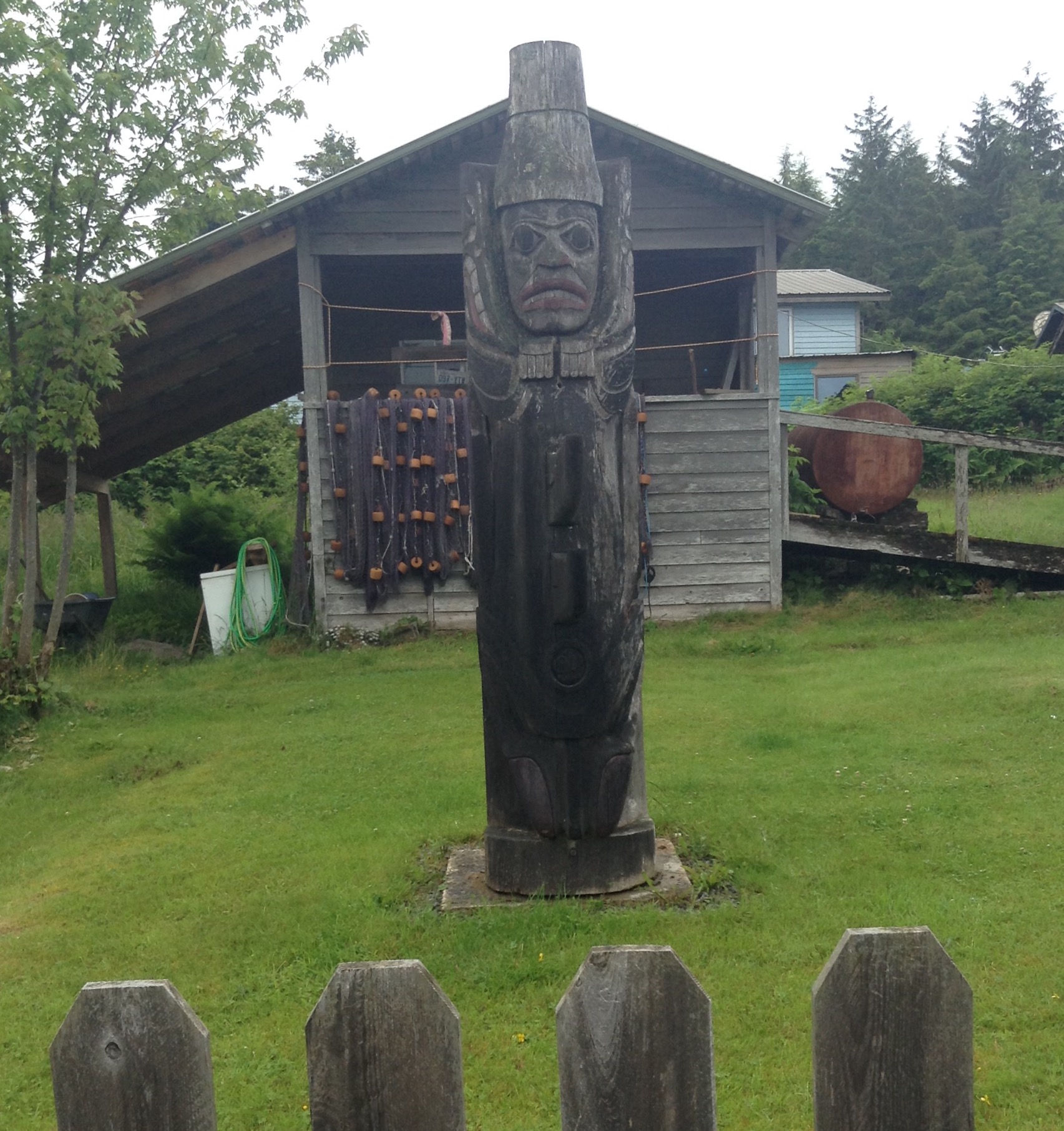
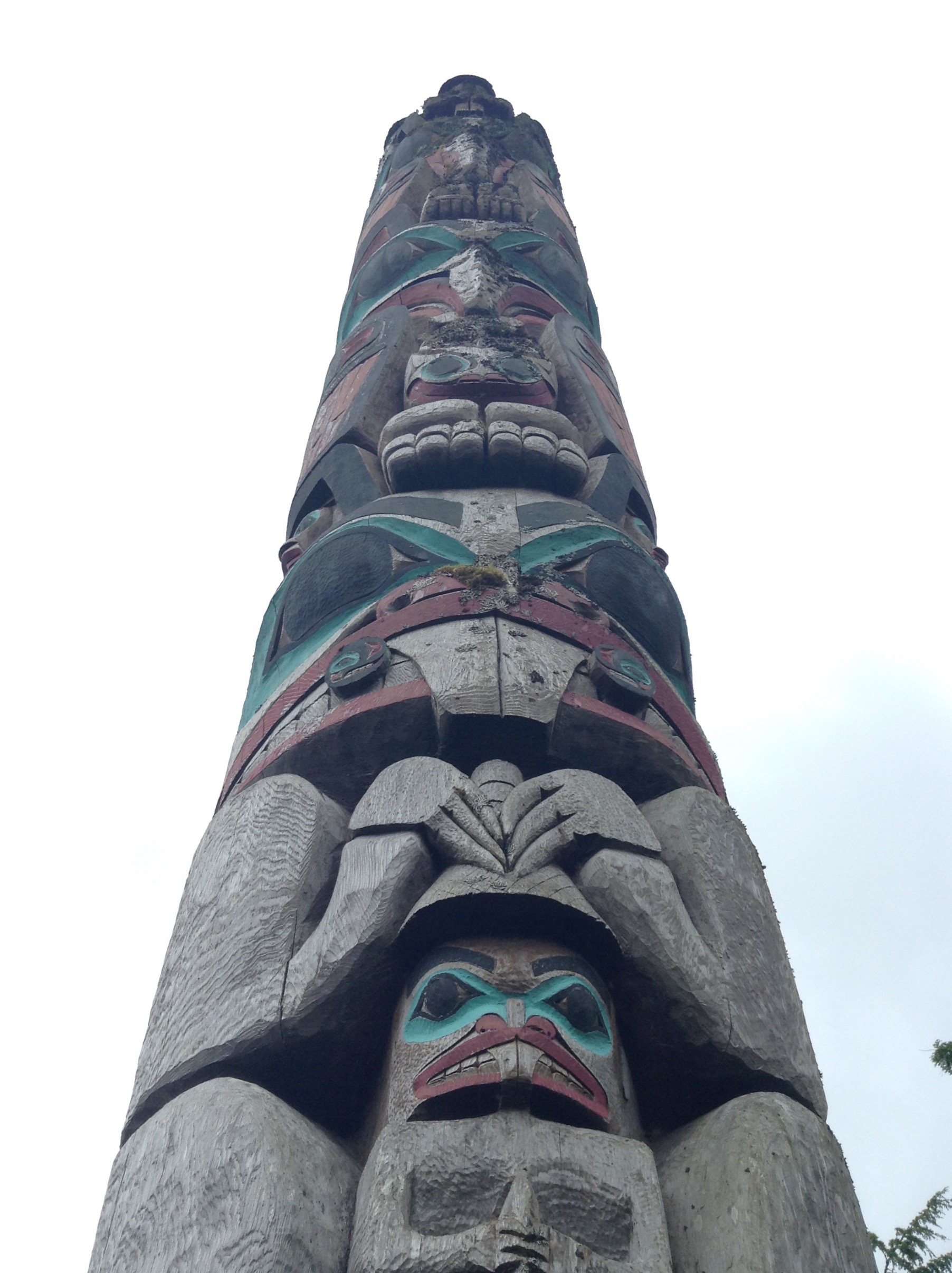
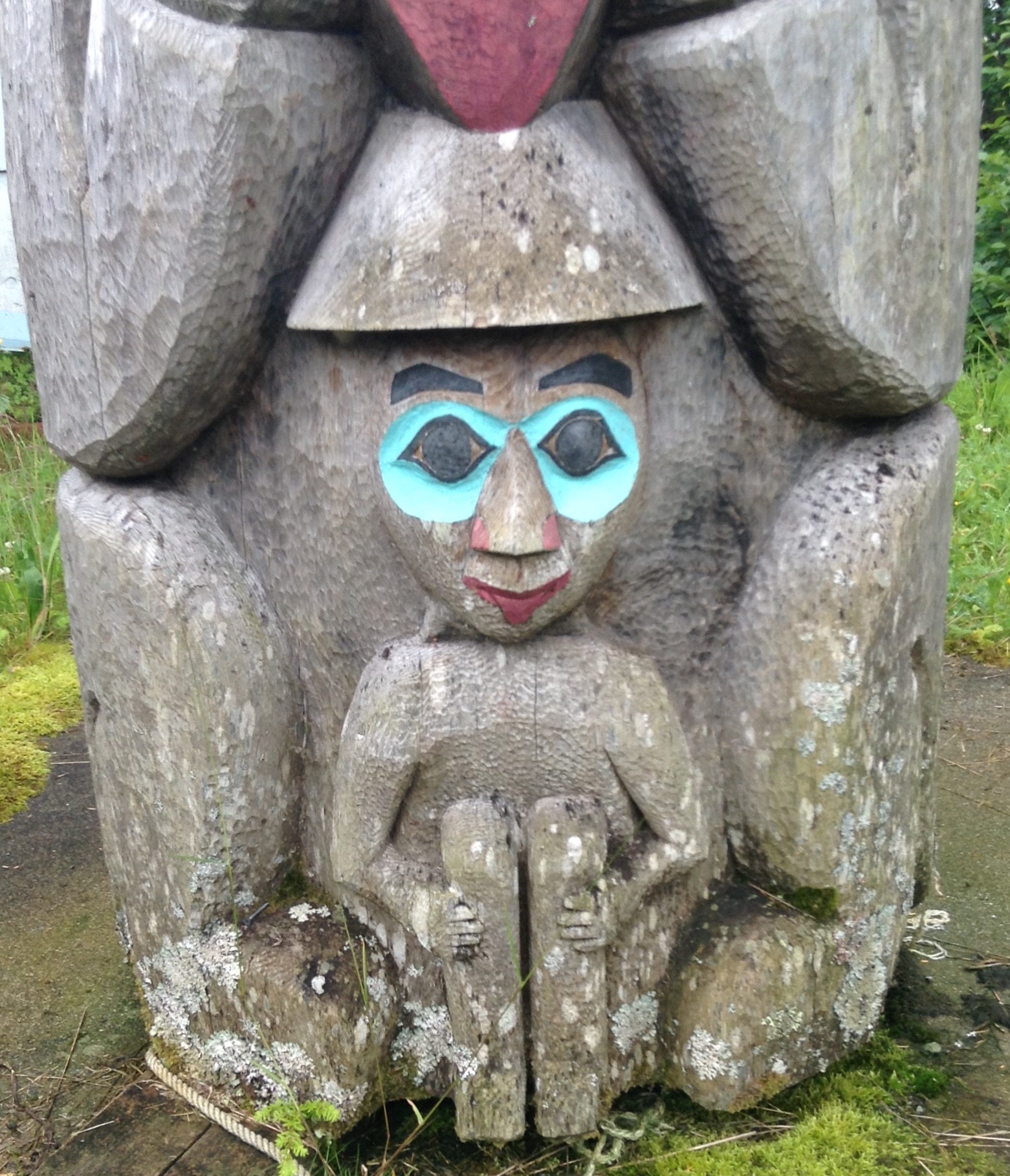
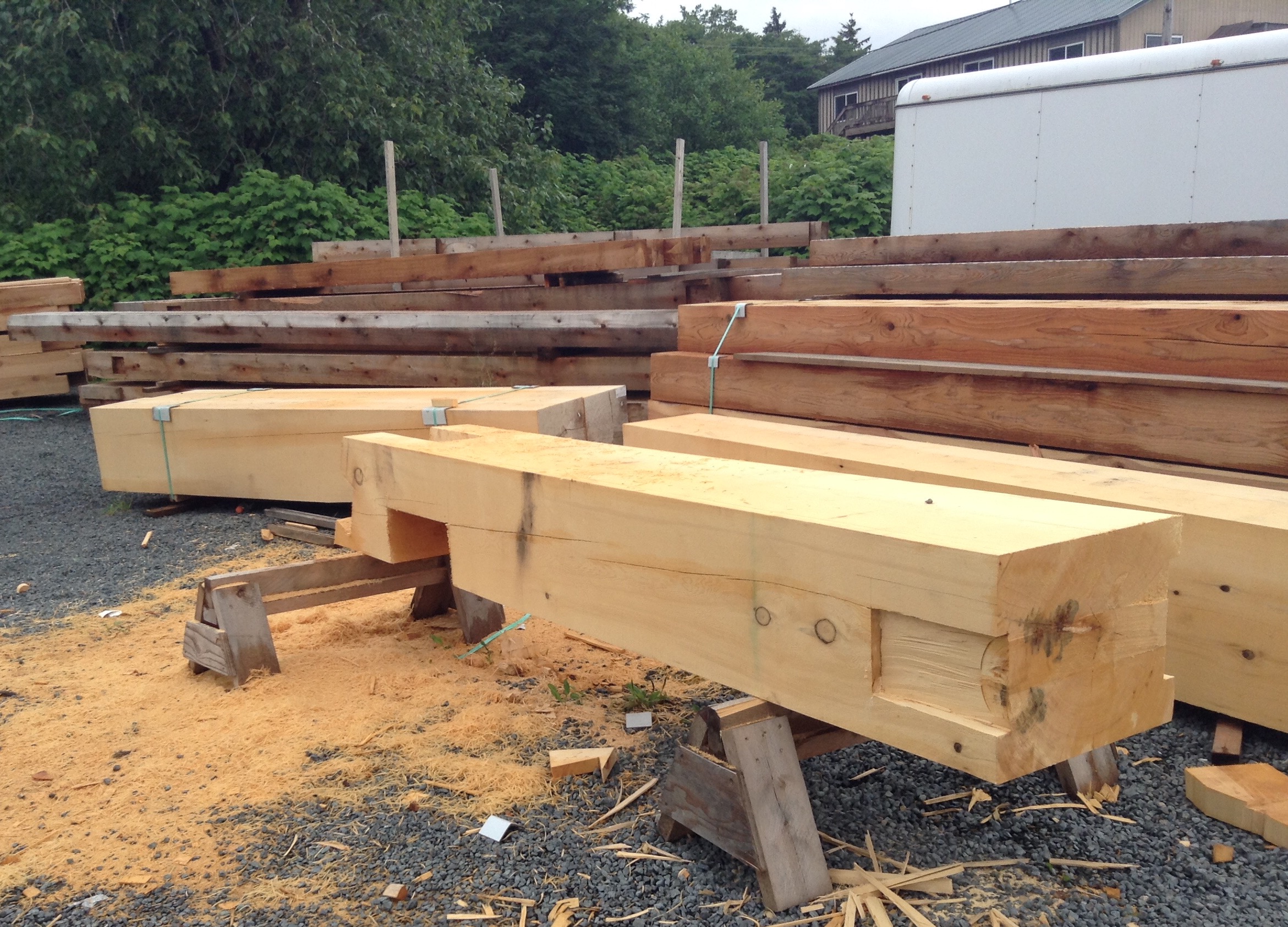
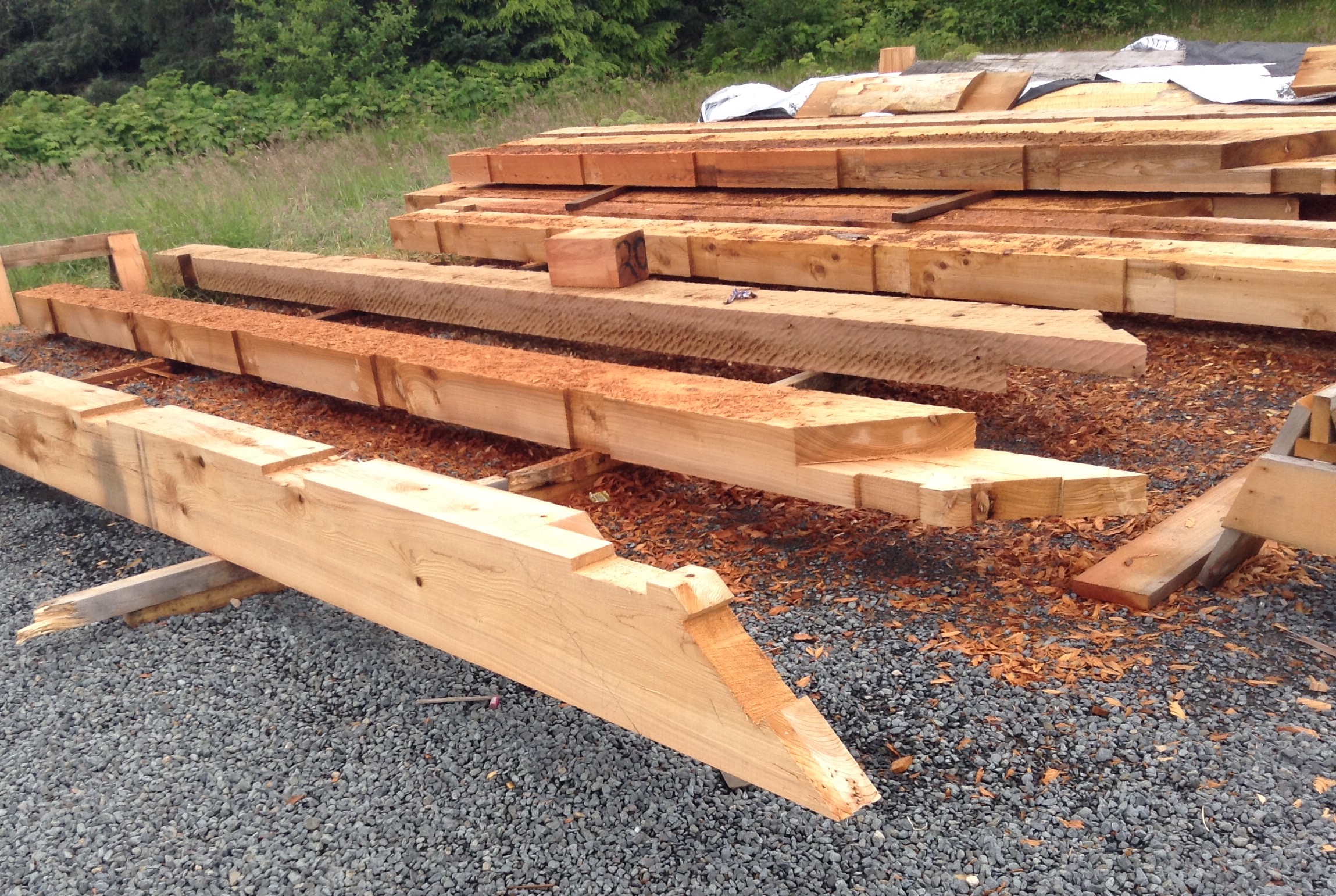
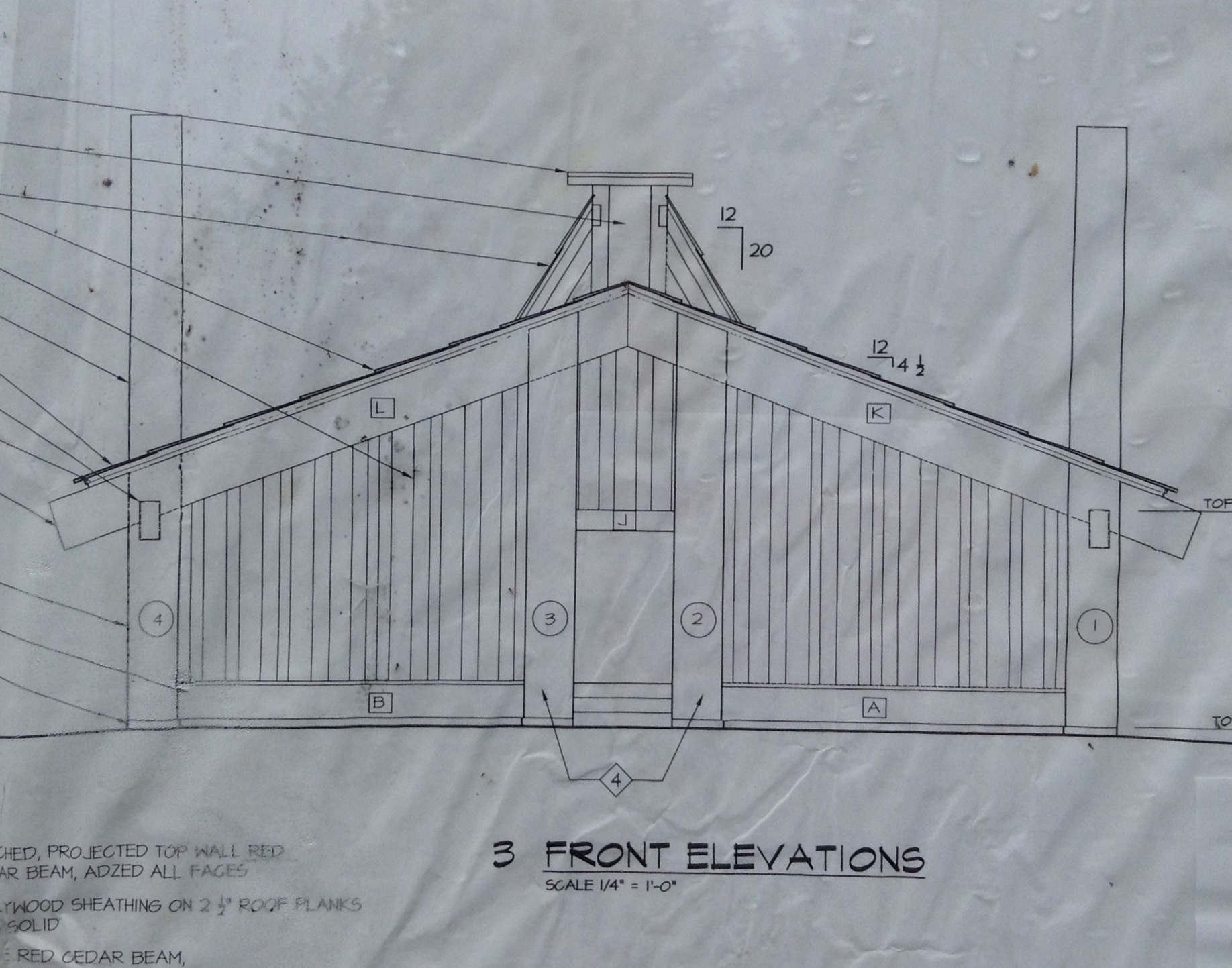
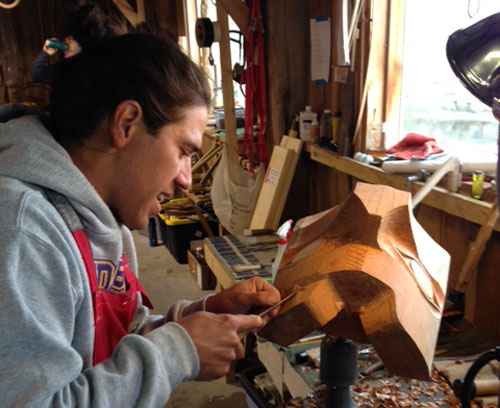
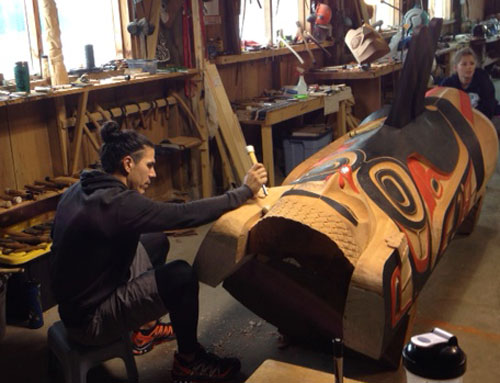
July 11 - Hydaburg
We'd planned to head out early today but the weather report sounded like it would be a bash. Nicer tomorrow, so we stayed another day.
The wharfinger came by and told us we could get internet at City Hall, so we walked back into town. On the way we met Irene, who welcomed us and gave us information about the town, incuding an invitation to attend cultural celebrations here the last week of July. She invited us to stop by her smokehouse later. At City Hall we meet Stacia, who is a great ambassador for Hydaburg. She is proud of the new docks, the new seafood processing plant, and the community efforts to entice tourism with new cabins. There's a lot going on, not the least of which is the new longhouse, set to open next year. We stop at the site and check out the huge yellow and red cedar beams that will go together like a giant puzzle with few fasterners, in the traditional way. All surfaces are textured with adze chips.
Again we are struck by all that Hydaburg has going for it, despite the collapse of fishing and lumber. If this were closer to Ketchikan, cruise ships would be parked out front. Tourism will maybe save the town, but will also forever change it.
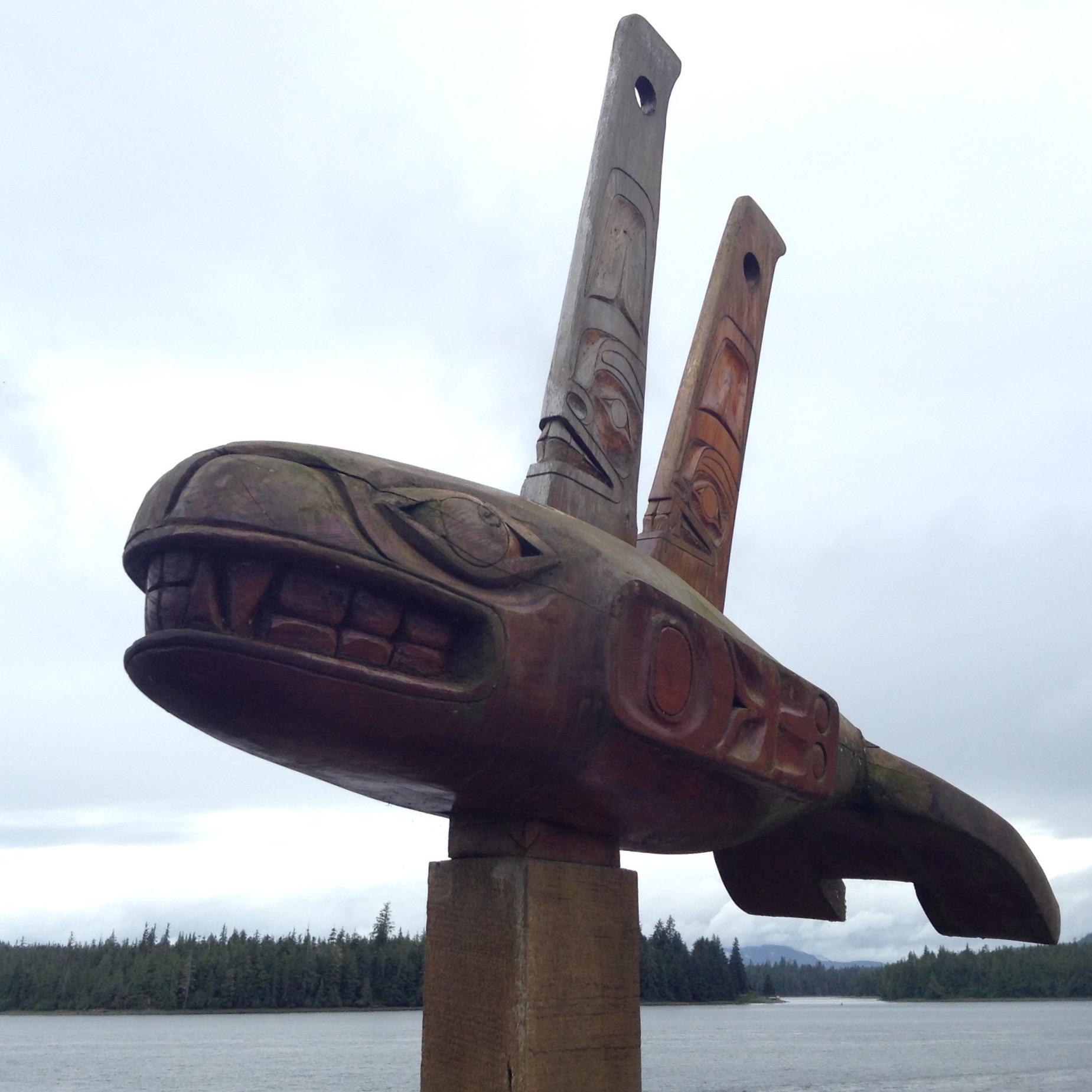
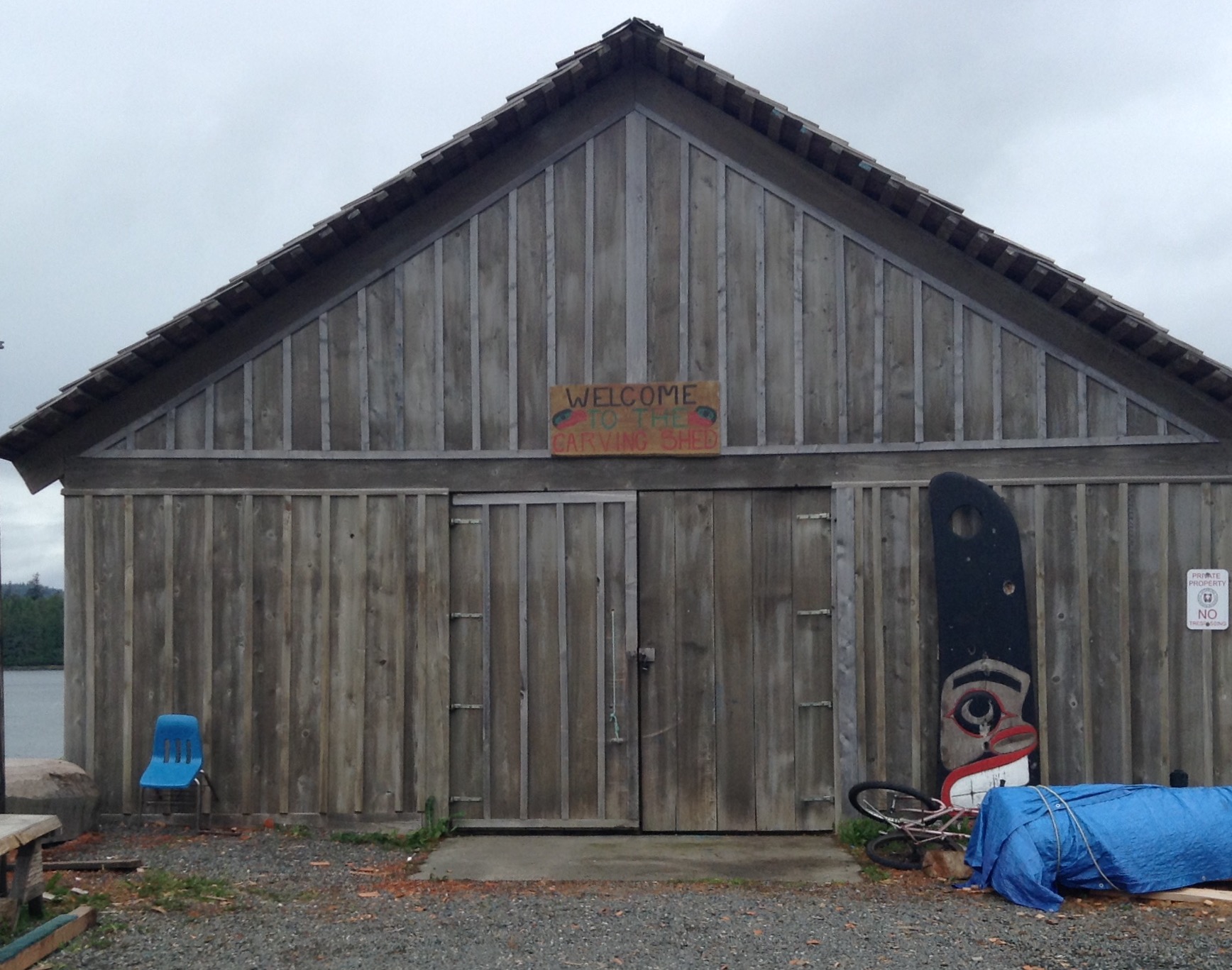
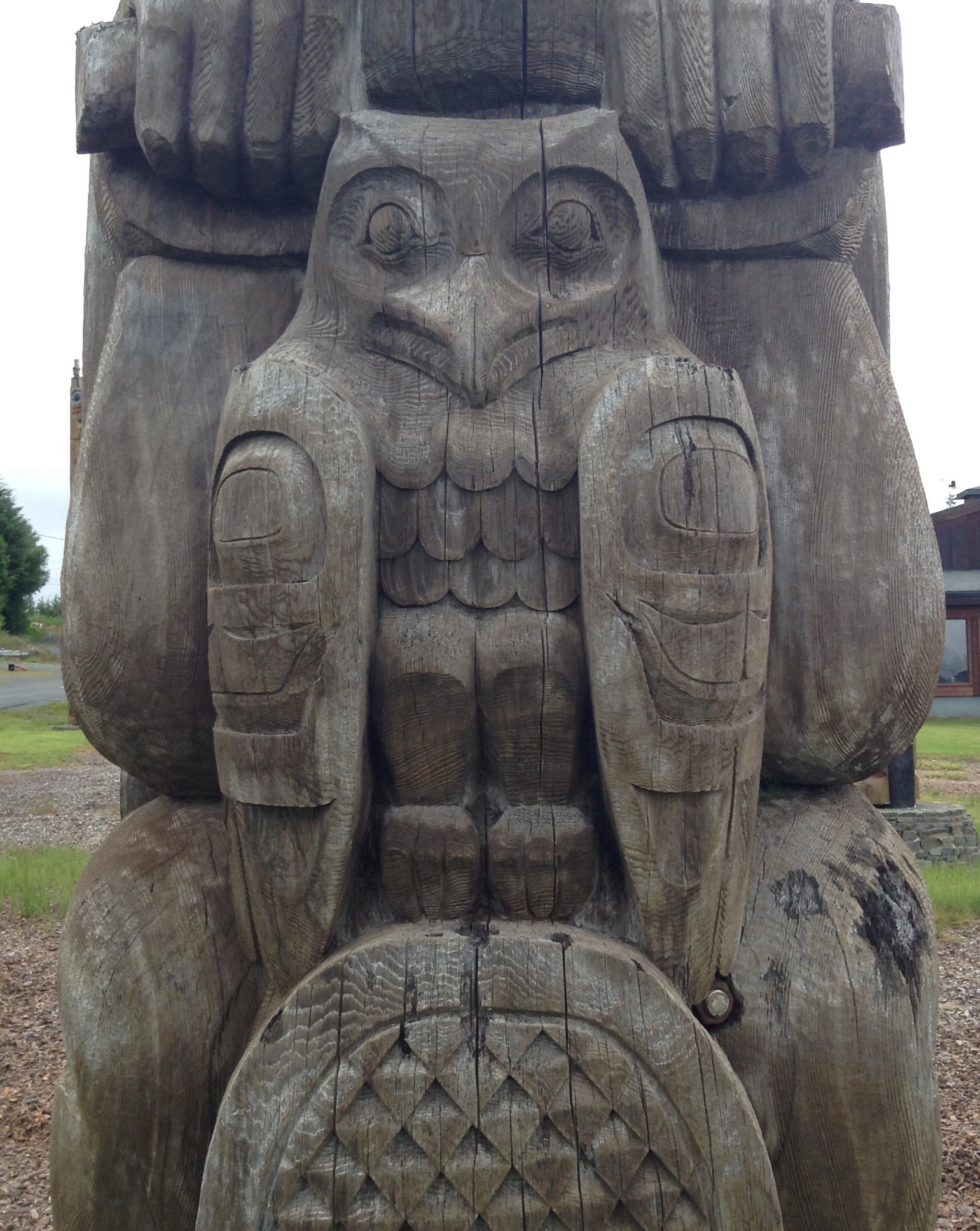
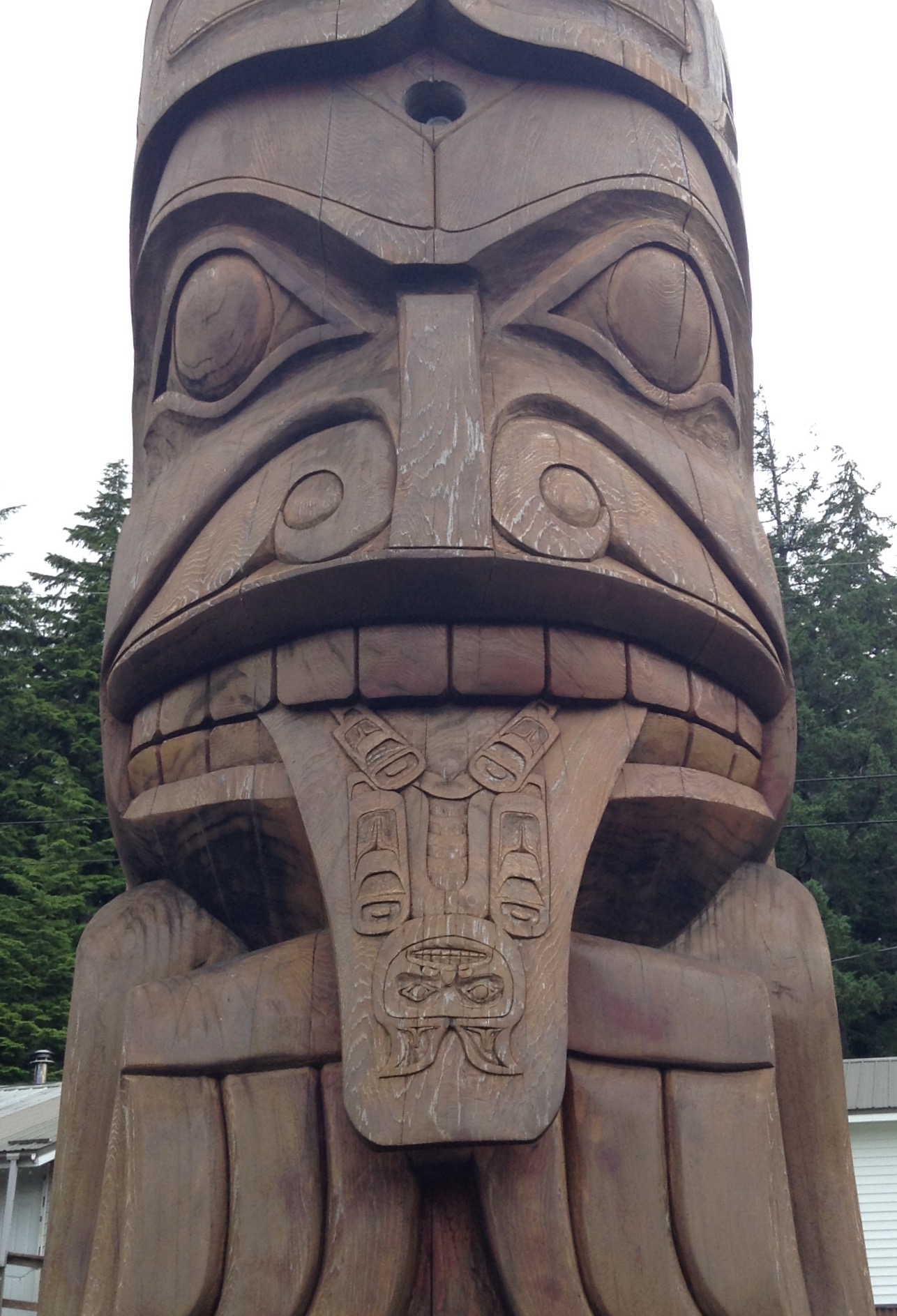
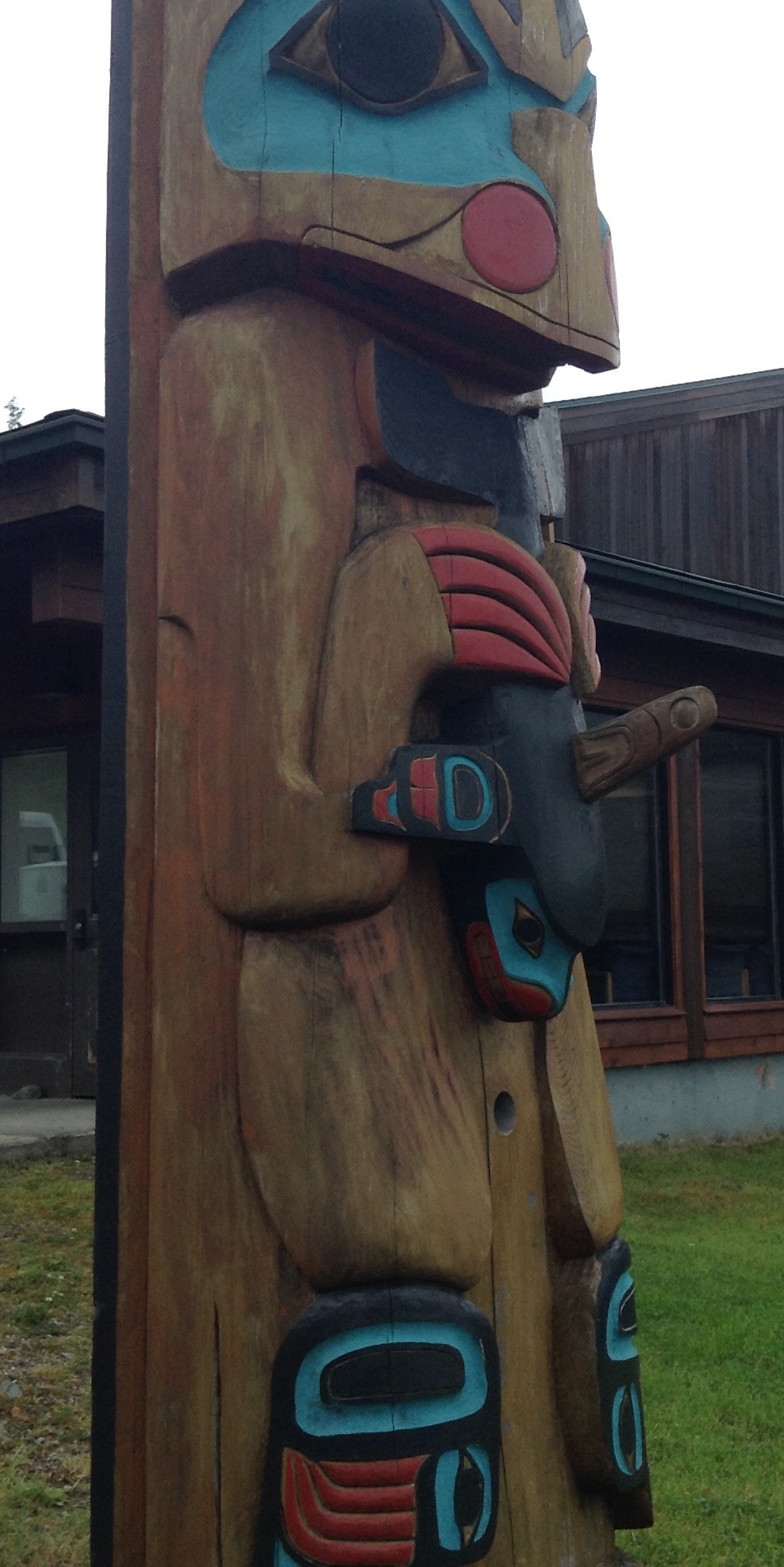
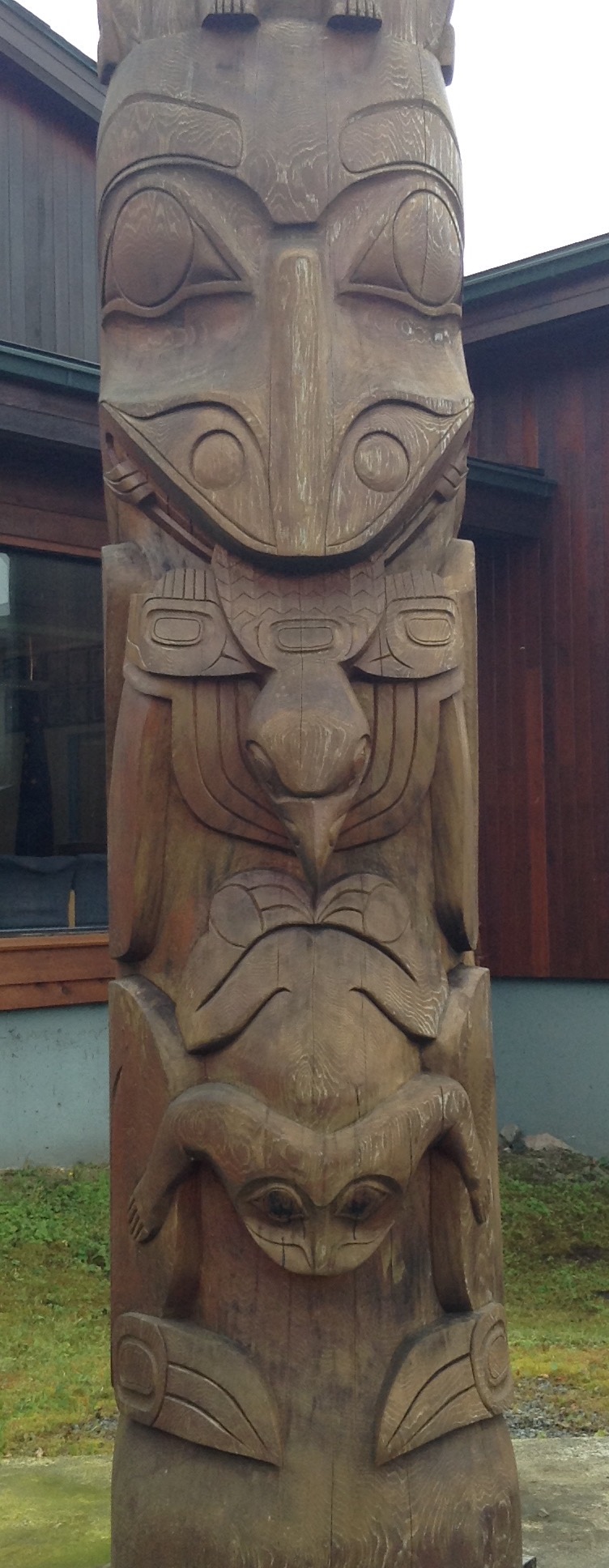
July 12 - Nichols Bay, Prince of Wales
Last night Walter Frank walked up the dock and greeted me, then regaled me with stories of his life and Hydaburg, including a fish story. He was with a nephew in his skiff, with a borrowed halibut hook when he caught a big one. He realized he couldn't get it in the skiff without capsizing, so he wound a line around a stick, and thrust that through the halibut's mouth and gills, then tied the fish off to the boat. He still couldn't lift it aboard, so they drug it to shore, then were able to get it into the boat. He says it weighed 200 pounds.
During the night we felt an odd bump. The motion of the current apparently tugged our stern line free, and we were hanging off the bow and midship lines. Yow.
This morning we woke at 5 and decided to grab the favorable current. We rode it past our planned stops at Mable Bay, then past Charlie's Cove in the Barrier Islands. Still no wind and small seas, so we carried on to Nichols Bay, at the south end of Prince of Wales, where we are parked halfway up the long bay just north of the protusion that resembles a doorknob.
The Barrier Islands are gorgeous but rugged, facing the full wrath of Dixon Entrance. Calm day, very fair conditions, though we still felt the tide rips at the south end of PoW. Tomorrow we again plan to ride the current eastward to Duke or Dundas, then the next day reach Prince Rupert. We are headed there to clear in to Canada. Right now we are a mere 30 miles from Masset, Haida Gwaii, but they no longer allow boats to clear in there, so we have a 4-5 day detour to PR.
This ends our 2017 Alaska log. Click here to continue on with Baraka to Haida Gwaii.